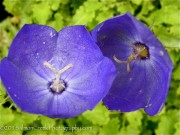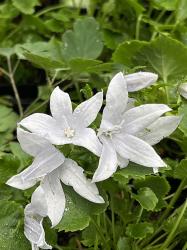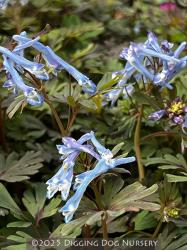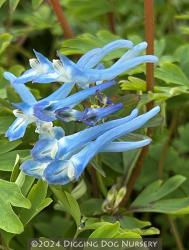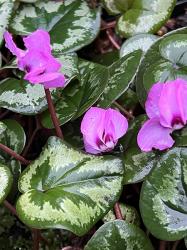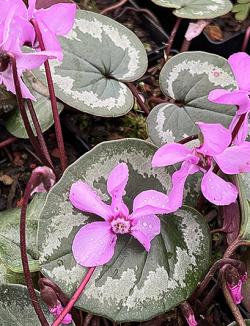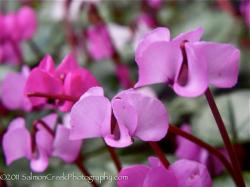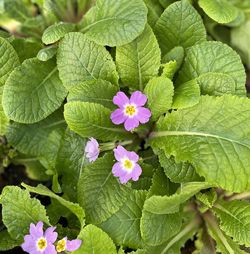Including Baptisia, Brunnera, Campanula, Corydalis, & Crocosmia
Ballota pseudodictamnus (P-0019)
Each $11.50
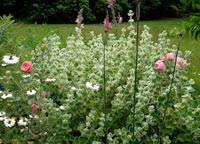
White woolly, rounded 1 in. leaves and furry stems, soft as chamois, steal the show here. Though the tiny white blooms are insignificant and should be sheared off to maintain an appealing bushy, yet compact form, Ballota sparkles against deep greens and bronzes. Acquiescent to drought, salt spray and high winds, it begs good drainage and protection from excessive winter wet. This illuminated Mediterranean mint makes an excellent choice for borders, banks and rock gardens and was once prescribed by Dioscorides as an antidote for the bite of a mad dog.
Blooms July – August.
Size: 18" high x 18" wide.
Zone 7/8.
Baptisia
False Indigo
Distinguished by their stately postures, these long-lived Legume family members grow wild in the eastern and southern regions of this country. A handsome mass of leaflets grouped in threes and erect, branching stems produce showy spires adorned with small, sweet-pea-like blooms. Easily cultivated in well-drained sites, Baptisias tolerate poor, sandy soil and some drought, but resent having their roots disturbed.
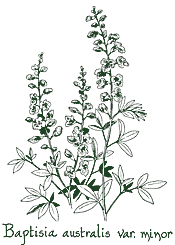
Softly colored racemes laden with lavender-blue, sweet-pealike flowers sway well above a compact assemblage of rounded blue-green leaves. Displaying a stance and foliage about one half the size of Baptisia australis, this superb variety’s nearly 2 ft. tall blooms are unparalleled. Later, large brownish black, papery seed pods form, which bring captivating visual accents, and even rattling sounds to arrangements.
Blooms mid-April–early May.
Size: 15" – 2' 0" high x 2' 0" wide.
Hardy to zone 4.
Baptisia x bicolor ‘Starlite’ (P-1438)
OUT OF PRODUCTION AT THIS TIME
Email me when this plant is available
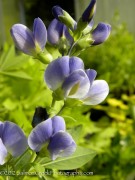
Twinkling like stars, a sky full of lupine-like periwinkle-blue flowers are set aglow by creamy white bases, known as keels. The deep violet-lavender buds populate numerous 2 ft. tall bicolored spires rising above blue-tinged oval leaflets on gently arching stems. Bred by Dr. Jim Ault from the Chicago Botanical Gardens, this robust australis and bracteata cross is a medium-sized, soft-hued perennial that can be paired with Centaurea 'Purple Heart' for an engaging medley. (ppaf)
Blooms May – June.
Size: 3' 0" – 4' 0" high x 3' 0" – 4' 0" wide.
Hardy to zone 4.
Baptisia ‘Ivory Towers’ (P-1976)
OUT OF PRODUCTION AT THIS TIME
Email me when this plant is available
Newly introduced by acclaimed plantsman Tony Avent, this tall ultraclassy Baptisia alba hybrid is included in the Mt. Cuba Center’s top-10 Baptisia list for its consistent standout attributes. Towering pure white flower spikes surmount tall sturdy stems that emerge with dark purple tints, crafting eye-catching contrast. Trim, glaucous bluish green leaves sprout well above ground level to reveal more of the sleek upright stalks, while both the luminous flowers and large fruit beguile garden visitors and flower arrangers alike. (pp#26,827)
Blooms late May–June
Size: 5' 0" high x 4' 0" wide.
Hardy to zone 3.
Baptisia ‘Purple Smoke’ (P-2126)
Each $11.75
An elite member of Mt. Cuba Center’s top-10 Baptisia line-up, this high-performing 1996 introduction originated at N.C. Botanical Garden as a chance seedling between Baptisia minor var. aberrans and Baptisia alba. Dapper clover-style gray-green leaves clothe the ultravigorous inky-green stems that hoist a slew of enormous upright 15 in. racemes loaded with Lupine-like smoky-violet flowers. A butterfly’s destination and a floral designer’s delight, ‘Purple Smoke’s easygoing, water-thrifty habit can be planted alone or in small swaths, furnishing decorative cylindrical seed pods plus a striking vertical element amid Amsonia hubrichtii and Sorghastrum ‘Indian Steel’.
Blooms late May–June
Size: 3' 0" – 4-1/3' high x 3' 0" – 4' 0" wide.
Hardy to zone 4.
Baptisia ‘Royal Purple’ (P-1831)
Each $11.75
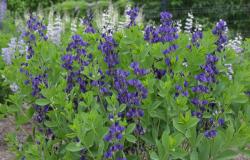
Populating dramatic 1 ½ ft. tall spires, ‘Royal Purple’s ample dark violet blossoms exhibit the most opulent, deep purple coloration of all the trialed Baptisia cultivars at Delaware’s highly acclaimed Mt. Cuba Center. This impressive Chicagoland introduction boasts a bumblebee haven of blooms, plus an attractive shrub-like habit with tailored blue-green foliage, lengthy seasonal interest and a virtually pest-free vigor. (PPAF)
Blooms May–June
Size: 3' 0" – 4' 0" high x 3' 0" – 4' 0" wide.
Hardy to zone 4.
Baptisia ‘Solar Flare’ (P-1642)
Each $11.75
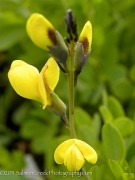
Distinctive for its lemon yellow flowers blushing an array of rich orange and violet hues as they mature, ‘Solar Flare’ lends sunny charisma to any border. The copious blooms are held on tall spikes well above dapper blue-green leaves, which frame a stylish vase-shaped habit with a broad dense head.
A complex hybrid of Baptisia tinctoria, alba and australis developed by Dr. Jim Ault, this fabulous, new bicolored cultivar demonstrates un-bridled vigor and makes an uplifting complementary statement alongside Asclepias ‘Soulmate’. (pp#20,408)
Blooms late May – June
Size: 3' 0" – 4' 0" high x 4' 0" – 4-1/2' wide.
Hardy to zone 4.
Baptisia x variicolor ‘Twilite’ (P-1439)
Each $11.75
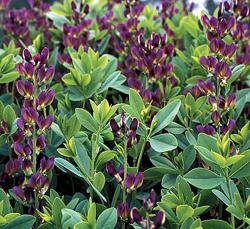
Hosting roughly 100 bicolored flowering stems in just 3 years time, this Dr. Jim Ault cross between australis and spaerocarpa exudes vitality galore. The appealing bushy blue-green pedestal shoulders 32 in. tall spikes studded with umpteen dark coppery-purple blooms enhanced by lemon-yellow keels. Marvelous in bud with bright green calyxes and buttery tips, and later infused with violet as the blossoms age, ‘Twilite’s unique floral hues make a toasty counterpoint to its cool-toned foliage that looks neat all season. (PPAF)
Blooms late May–June
Size: 3' 0" – 5' 0" high x 4' 0" – 5' 0" wide.
Hardy to zone 4.
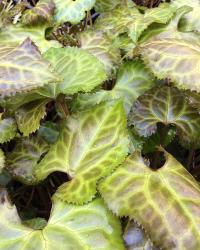
A fabulous Dan Hinkley introduction, from a 1998 Sichuan Province collecting trip, False Bugbane sports slender spikes of dainty white flowers poised above dapper heart-shaped leathery foliage with a marooninfused lacquer-like sheen. The low growing evergreen rosette slowly forms a splendid undemanding ground cover that is further enhanced by intriguing venation, softly toothed foliar margins and purplish brown petioles. Beesia deltophylla belongs to the Buttercup family and is well-suited for the woodlands or underneath high canopies, where it glimmers amid companions such as Corydalis, Cyclamen or Ferns and revels in moist but not soggy compost-enriched soil.
Blooms May–June.
Size: 18" high x 18" wide.
Hardy to zone 6.
Begonia
Hardy Begonia
These stellar perennial selections promote good-looking deciduous foliage and captivating clusters of colorful dangling blooms. Filtered shade, rich fast-draining soil that stays moist but not water logged, and a layer of mulch for winter protection ensure their well-being.
Begonia grandis ssp. evansiana (P-2277)
Each $11.75
The specific epithet, which means big or showy in Latin, says it all! Indigenous to China, this hardy tuberous Begonia fashions a handsome bushy mound of thick and fleshy, jointed stalks with irregular red bands plus large asymmetrical olive-green leaves sporting cordate bases, notched margins and fantastic red veins on the pale grayish green flip sides. Loose, long-stemmed nodding clusters house red buds and splendid scented pearly-pink blooms from July through October, at which time the entire plant disappears. Damp, partially shaded, well-drained nooks and mulch where winters are cold ensure its vitality, while Impatiens omeiana, Tricyrtis ‘White Towers’ and Athyrium ‘Metallicum’ make compelling companions.
Blooms July–October
Size: 2' 0" high x 2' 0" wide.
Hardy to zone 6.
Begonia grandis ssp. evansiana ‘Alba’ (P-1924)
Each $11.75
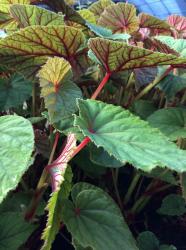
This fetching winter-hardy tuberous Begonia has lots to toot its horn about. The mounded, gleaming green clump presents attractive, large angel-wing leaves that sport red veins, branched stems with cardinal-hued nodes and exquisite panicles of yellow-centered white flowers. A perfect companion for fellow shade dwellers like Pulmonarias and Impatiens omeiana, ‘Alba’ appears late spring, requiring mulch in cold winter locales and slightly acidic, well-drained moisture-retentive soil.
Blooms July–September
Size: 18" – 2' 0" high x 12" – 18" wide.
Hardy to zone 6.
Begonia grandis ‘Herons Pirouette’ (P-1643)
Each $11.75
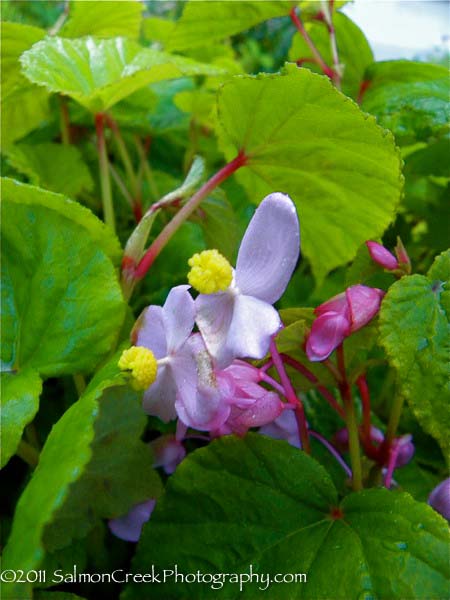
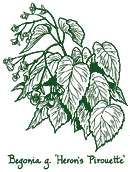
Though the polished triangular foliage resembles the species, it was the masses of deep pink, nearly 12 in. long flower clusters, pirouetting with a dancer’s grace that caught Dan Hinkley’s keen eye during a 1997 Japanese expedition. Draped on slender pendulous stems, the richly hued flowers, highlighted by lavender accents, deliver a splendid nonstop performance from June until fall; later warm pink seed heads provide a midautumn encore. This delicate-looking Begonia is an excellent choice for a container or for massing as a bedding plant.
Blooms June–October
Size: 15" high x 15" wide.
Hardy to zone 6.
Each $11.75
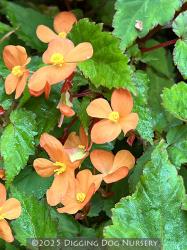
A hardy denizen of Kwazulu-Natal in South Africa, this exotic-looking tuberous Begonia sends up jagged-edged bright green foliage beneath a lovely cascade of clear orange flowers supported by pale red stems. The alluring summer long display complements Bletilla ‘Soryu’ or Saxifraga ‘Maroon Beauty’.
Blooms June–August
Size: 6" high x 18" wide.
Zone 7/8.
Bergenia
Pigsqueak
You can experience how this no-trouble rhizomatous ground cover earned its common name if, following a rain, you rub a leaf between your fingers—but it is Bergenia’s fine firm foliage mass and waxy Saxifraga-like flowers that justify its presence in the garden. With bold rounded outlines, the great, glossy, and nearly evergreen, rich green leaves are a handsome backdrop for dense heads of delightful spring blooms that rise above the cabbage-looking rosette on stalwart red-tinted stems. In winter, leaves become tinged with burgundy and are most welcome in holiday arrangements. Bergenia endures neglect, poor soil and some drought, but performs best in part shade.
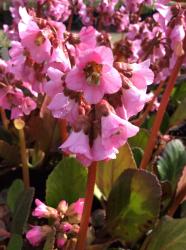
A 1972 Eric Smith hybrid raised at Britain’s Hadspen House, this rarely offered Bergenia emphasizes arresting contrast. Enhanced by rose-blushed centers, flamboyant red calyces and hefty burgundy-hued stalks, the massive, densely set flower heads initially develop a soft pink coloration, which dramatically matures to white above thick deep green leaves. The tailored evergreen clump can be planted in drifts as an easily grown ground cover, broadcasting bold lustrous texture plus warm coppery red winter highlights.
Blooms April–May
Size: 16" high x 18" wide.
Hardy to zone 3.
Bergenia ‘Bressingham Ruby’ (P-1248)
Each $12.50
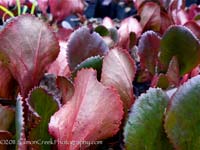
Amidst a compact base of lustrous greenery, glistening deep rosy-red Hyacinth-like blooms herald spring, and later the foliage transmutes bronzed-wine tints that animate winters’ somber landscape. This gem’s tidy habit is well suited for edging a path or for gracing a container at any time of year. (PP#7,344)
Blooms April–May
Size: 16" high x 18" wide.
Hardy to zone 4.
Bergenia ‘Bressingham White’ (P-1170)
Each $12.50
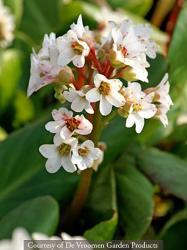
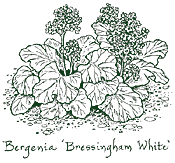
Esteemed for the subtly blushed white color of its mature blossoms, its amazing floriferous nature, and for its leafy robustness, ‘Bressingham White’ was bred by British horticulturist Alan Bloom. To create an eye-catching contrast of color and texture, combine this Bergenia’s broad leaves with the ferny foliage of Aruncus ‘Guinea Fowl’.
Blooms April–May
Size: 12" – 15" high x 18" wide.
Hardy to zone 4.
Bergenia cordifolia ‘Winterglut’ (P-1912)
Each $12.50
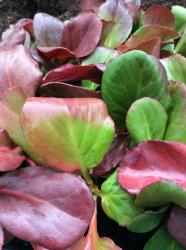
This superb prismatic cultivar claims its name with striking, red-painted winter foliage that chases the chill from a December day and warms a holiday wreath. The substantial slow-spreading rosettes of beefy, heart-style polished leaves launch showy magenta-red flowers perched on steadfast stalks. Vaunting color aplenty, nearly 4-season appeal and an adaptable valiant bearing, ‘Winter Glow’ can be added to the rockery or a border’s front lines.
Blooms April–May
Size: 18" high x 15" wide.
Hardy to zone 4.
Each $12.50
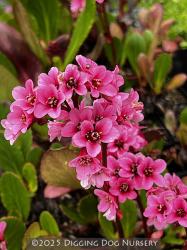
Wildly popular in Europe, this unfaltering AGM recipient is one of the most floriferous Bergenias, delivering long-lasting, richly hued purplish pink flower clusters atop staunch, tall branching green stalks that are dappled with auburn highlights. The broad, rounded wavy green leaves foster a gleaming finish plus impressive frost tolerance and show-stopping coppery-beet-red tones for winter. A colorful nearly-evergreen perennial, ‘Eroica’ can garnish borders, shrub plantings, stairways and rock gardens, as well as bouquets and holiday greenery.
Blooms April–May
Size: 12" – 18" high x 18" wide.
Hardy to zone 4.
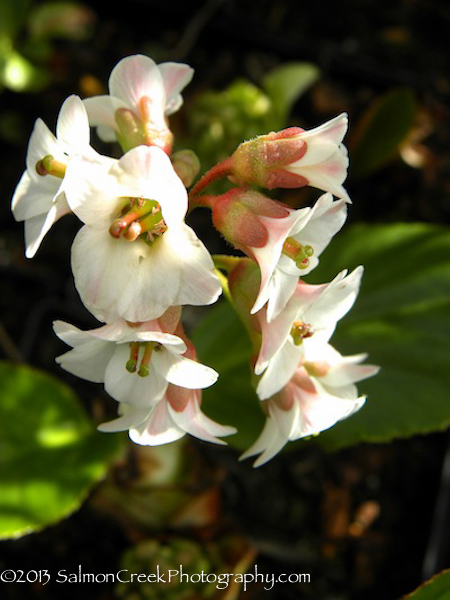
Big varnished rosettes of firm, extralarge rounded evergreen foliage beam purplish bronze colors that indeed work magic on a bleak winter landscape. A verdurous foil the rest of the year, dark green leaves reach up to a foot long and 9 in. across, while supporting dense rosy-pink flower clusters, defined by red centers, white stamens and open starry faces on stout wine-hued stems. Bedazzled with jewel tones and texture galore, this hybrid Bergenia crafts an exceptional, easy-care ground cover for moist poorly drained banks, streamsides or borders.
Blooms April–May
Size: 16" high x 18" wide.
Hardy to zone 3.
Bergenia ‘Pink Dragonfly’ (P-1865)
Each $12.50
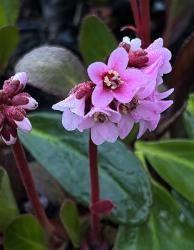
Though this cultivar is more diminutive than our other Bergenia selections, its year-round merit is huge. Narrow jade-green leaves compile a gleaming evergreen base that launches lovely clusters of bright pink flowers, looking a bit like cherry blossoms, on thick burgundy-tinted stems. Introduced by German-born Anne Eskuche, ‘Pink Dragonfly’s enticements extend far beyond the perfectly proportioned blooms as unique plum-red shades morph the foliage into a colorful winter spectacle.
Blooms April–May
Size: 12" – 15" high x 12" – 18" wide.
Hardy to zone 4.
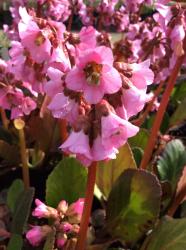
Highly regarded by British plantswoman Beth Chatto for their lovely presentation, the salmon-tinged rosy pink Hyacinth-like floral bells ring in spring with open flared mouths above a tight-knit smaller-sized foundation of gleaming spoon-shaped foliage. ‘Rosi Klose’s profuse uniquely hued blooms and verdant trouble-free disposition can enhance the rockery, a stone wall or pond’s edge.
Blooms April–May
Size: 12" high x 15" wide.
Hardy to zone 4.
Granted a well-earned 2009 AGM, ‘Wintermärchen’s winning year-round habit affords splendid, late-appearing pink-tinged white flowers, as well as prismatic cold weather charm. The pendulous bee-friendly blooms sojourn atop staunch reddish stems and a lush ultracold-hardy foundation. Smaller than most Bergenias, the polished green leaves grow in a distinctive vertical fashion, developing a somewhat elongated shape and later proving the namesake, which translates to ‘Winter Fairy Tale’, when warm scarlet and rubescent shades set them ablaze. Anemone leveillei and Geranium ‘Claudine Dupont’ make amiable companions.
Blooms late April–early June
Size: 12" – 15" high x 18" wide.
Hardy to zone 4.
Bletilla
Terrestrial Orchid
This nontemperamental terrestrial orchid debuts lovely Cattleya-shaped flowers with wide open mouths and finely pleated floral pouches. Perched on slender stems, the luxe blooms adorn a cold-hardy medium green clump of attractive, ribbed Iris-like leaves that slowly spread by tuberous rhizomes. Bletilla adore dappled shade, heavy winter mulch and evenly moist, well-drained sites, while withstanding occasional drought.
Bletilla striata ‘Alba’ (P-2167)
Each $11.75
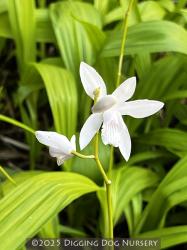
An inhabitant of China and Japan, this easy-care terrestrial orchid proffers long-lasting racemes distinguished by ornate Cattleya-style pearl-white flowers. The pleated sword-shaped greenery sends forth 18 in. stems, each with five to ten exotic-looking blooms donning furrowed lower lips. Content in dappled light and moist, well-drained, enriched nooks, ‘Alba’s slow-spreading rhizomes foster hardy pest-free colonies whose glimmering floral elegance can illuminate beds, borders, rock gardens and containers.
Blooms June–July
Size: 18" – 2' 0" high x 18" – 2' 0" wide.
Hardy to zone 6.
Bletilla striata ‘Alba Variegata’ (P-1977)
OUT OF PRODUCTION AT THIS TIME
Email me when this plant is available
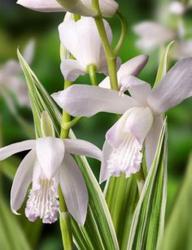
‘Alba Variegata’s claim-to-fame is the delicate pearl-colored flowers, whose tips are blushed with subtle mauve shades, plus its broad blade-like leaves that are embellished with creamy white margins and interior streaks. Steeped in ornate elegance, 3 to 7 luminous flowers gather on slender stems above an undemanding artful stand of variegated foliage.
Blooms April–July
Size: 15" – 2' 0" high x 12" wide.
Hardy to zone 6.
Discovered years ago in Japan’s Wakayama region and plagued by rumors of being too temperamental, this chic seed-grown terrestrial Orchid is easy to grow, but still hard to find. The appealing medium green clump hosts enchanting blue-violet blossoms that are a beacon of sophistication for containers or jewel box plantings. Bletilla adore dappled shade, heavy winter mulch and evenly moist, well-drained sites, while withstanding occasional drought.
Blooms April–July
Size: 15" – 2' 0" high x 12" wide.
Hardy to zone 6.
Boltonia
Thousand-Flowered Aster
This floriferous eastern American native was named after the British botanist, James Bolton, and for its butterfly-beguiling Aster-like blooms. Tolerant of clay soil and occasional dry conditions, Boltonia asteroides promotes an easy-to-grow pest-free habit with showy blooms that can grace native plantings or perennial borders.
Tootling the moist prairies, meadows and stream banks of eastern and central North America, this amenable Aster-like perennial rallies countless petite pale pink daisies with yellow eyes. Late summer finds upright branching stems and alternate linear grayish green leaves completely blanketed by the upbeat fine-rayed flowers that populate loose panicles. A winsome butterfly minion, ‘Pink Beauty’s slow-spreading rhizomes tolerate clay, but prefer good drainage, while a late spring lop plus somewhat drier soil will ensure stronger upstanding stems.
Blooms August–October
Size: 3' 0" – 5' 0" high x 3' 0" wide.
Hardy to zone 4.
Boltonia asteroides ‘Snowbank’ (P-0038)
Each $11.25
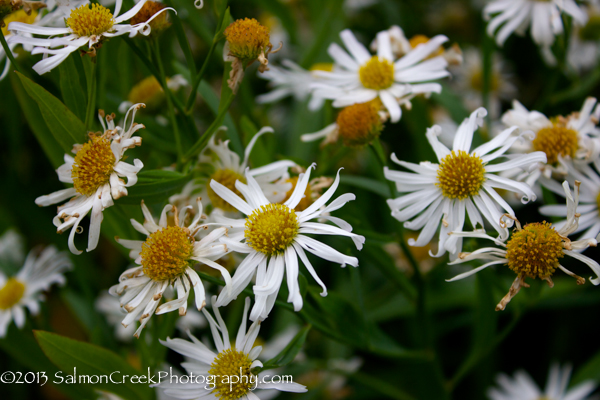
This natural beauty sports a just-blown-in appearance, forming a big billowy mass of small white daisy-shaped flowers and tasteful, linear gray-green foliage. Innumerable yellow-eyed “asteroides” shoot straight up on tall sturdy stems that seldom need staking and assert a strong vertical element. Cold-hardy ‘Snowbank’ can be associated with Helenium ‘Potter’s Wheel’, Kniphofia ‘Tawny King’ and Helianthus ‘Dakota Queen’ for a big boisterous late season gathering.
Blooms August–October
Size: 4' 0" – 5' 0" high x 3' 0" wide.
Hardy to zone 4.
Brunnera
Siberian Bugloss
Handsome and undemanding, this ground cover forms large, tidy basal clumps of long-petioled, broad foliage, and displays charming flowers that begin blooming in early spring and persist through Memorial Day. Appreciating some shade plus evenly-moist organic-rich soil, Brunnera is at home by water’s edge, en masse in the border, or as a filler between newly planted shrubs.
Each $11.75
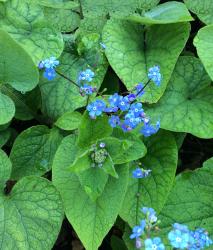
Lush heart-shaped, 5 in. wide dark green foliage plus wiry branched stems waving tiny intensely blue flowers with yellow eyes beg you to think “forget-me-not”. This solidly colored verdant departure from its variegated cousins brings tasteful leafy texture to shady borders or woodland gardens.
Blooms mid-February–June
Size: 12" – 15" high x 2' 0" wide.
Hardy to zone 4.
Brunnera macrophylla ‘Alexanders Great’ (P-1978)
Each $13.25
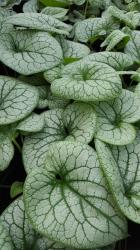
Introduced by Terra Nova Nursery in 2013, a stunning, gigantic mass of enormous heart-style silver leaves inscribed with contrasting green veins and margins glorifies this hearty Alexander Zukeivich discovery. Petite, yellow-centered sky-blue flowers held in airy sprays make a delightful lighthearted splash above the lucent, well-groomed mound. (pp#25,789)
Blooms mid-February–June
Size: 15" – 18" high x 2' 0" – 2-1/2' wide.
Hardy to zone 4.
Brunnera macrophylla ‘Dawsons White’ (P-1099)
OUT OF PRODUCTION AT THIS TIME
Email me when this plant is available
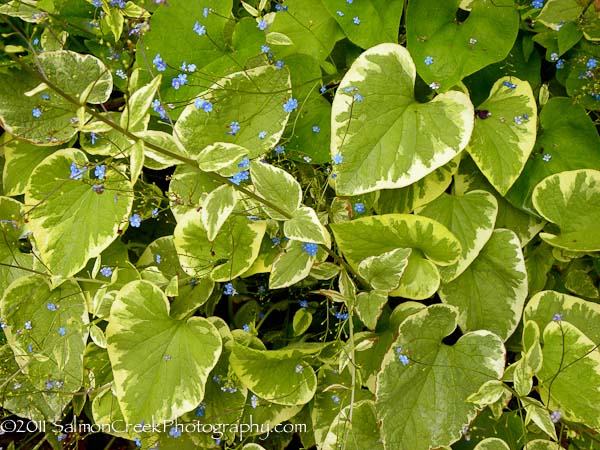
Boldly patterned with wide snowy-white margins and green centers, ‘Dawson’s White’ fashions a striking variegation that is further heightened by its endearing, forget-me-not–like azure-blue flowers. A shimmering addition for the shadows, this Brunnera needs protection from hot dry wind and too much sun.
Blooms mid-February–June
Size: 15" high x 2' 0" wide.
Hardy to zone 4.
Brunnera macrophylla ‘Hadspen Cream’ (P-0804)
Each $14.25
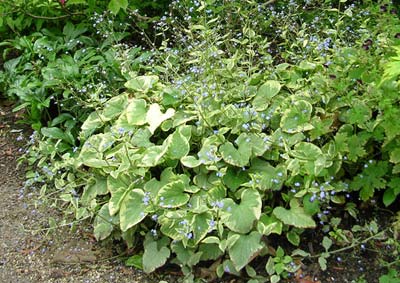
Not all variegated plants possess the sophisticated beauty displayed by this British introduction’s lovely foliage. It features felted, heart-shaped, pale green leaves, each rimmed with an irregular, rich cream-colored swath. Delicate sprays of starry blue flowers dance above on graceful stems, offering a soothing yet vibrant presence for a shady spot.
Blooms mid-February–June
Size: 15" high x 2' 0" wide.
Hardy to zone 4.
Brunnera macrophylla ‘Jack Frost’ (P-1353)
Each $13.50
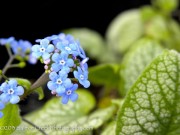
Awash in a mercury-like effulgence, broad heart-shaped leaves are etched by light green veins creating a dramatic crackled-ceramic pattern. ‘Jack Frost’s silvery persona offsets bronze, green and gold foliage, while sky-blue flowers add a playful lift. This refined Walters Gardens’ introduction originated from a ‘Langtrees’s sport and promises to furnish the darker alcoves of your garden with luminous accents (pp#13859)
Blooms mid-February–June
Size: 12" – 15" high x 2' 0" wide.
Hardy to zone 4.
Masterminded by Belgian plant breeder Chris Ghyselen, this Brunnera ‘Inspector Morse’ and Brunnera ‘Betty Bowring’ cross is wildly popular for its flurry of uniquely colored snow-white flowers. Airy branched racemes carry the small pearl-hued blossoms above dashing heart-style leaves bearing intricate silver and green tattoos. Whether in bloom or not, ‘Mr. Morse’s gleaming, easy-care persona can be ensconced alongside blue-blooming Brunnera ‘Jack Frost’ for a classy combination. (PPAF)
Blooms mid-February–June
Size: 12" – 18" high x 12" – 18" wide.
Hardy to zone 4.
Brunnera macrophylla ‘Silver Wings’ (P-1509)
Each $12.75
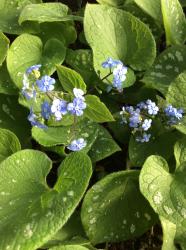
Encompassing each pewter-veiled leaf, a thin white margin illuminates this exceptional Brunnera ‘Langtrees’s sport introduced by Naylor Creek Gardens. Ample-sized, widely heart-shaped foliage has a central gray-green swath that separates the distinctive variegation and, in combination with the outlined edge, creates a winglike appearance. Tidy, vigorous and burn-resistant, the stylish gray frosted clump entertains plentiful clusters of long lasting, small wedgewood blue flowers. (pp#13706)
Blooms mid-February–June
Size: 12" – 15" high x 2' 0" wide.
Hardy to zone 4.
Each $12.25
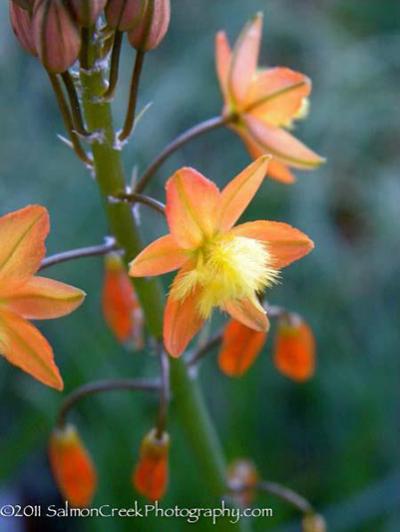
Reminiscent of an Aloe, this lush-looking Lily relative conceives a durable, yet attractive low succulent ground cover. Underground rhizomes give way to open fleshy rosettes of cylindrical, upright green leaves that are narrow and pointed. Alighting slender stems, triangular green buds unfurl long blooming dainty orange flowers with frilly yellow stamens from the bottom up.
An eye-catching South African evergreen, Bulbine frutescens requires little water and minimal care, though it enjoys a well-drained location and protection from cold winter nights.
Blooms April – August
Size: 12" – 2' 0" high x 3' 0" – 4' 0" wide.
Zone 9/10.
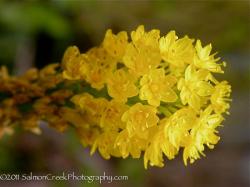
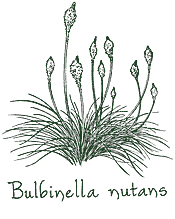
Hailing from South Africa’s Cape Province, this Asphodeline relative grows during the winter and is summer dormant. A bright green lustrous clump of channeled and grassy deciduous foliage celebrates long blooming, perfect-for-cutting, sunny yellow flowers. Described by numerous starlike florets, opening from the bottom up on erect cone-shaped racemes, the unfurled blossoms skirt beneath tight green buds and look a bit like ballerinas in frilly tutus alighting slender curving stems.
Most dramatic when planted en masse with Geranium harveyi and Euphorbia myrsinites, Bulbinella nutans is superb for naturalizing in a sunny, well drained, low-maintenance border where it can be kept dry during the summer, at which time its old leaves can be pulled off.
Blooms February–March
Size: 2' 0" – 3' 0" high x 2' 0" wide.
Hardy to zone 8.
Calamintha
Calamint
Our floriferous Calamintha selections feature tiny 2-lipped blooms on long cymes and round mint-scented leaves with toothed margins. Undeterred by heat, drought or meddlesome deer, this species should be ensconced along well-drained pathways or steps to easily savor its pleasant fragrance.
With a light-on-its-feet stance, this resilient new cultivar is a vast improvement over the species, boasting nonstop bloom and a tidy mounding habit that never flops. Small, mint-scented green leaves bolster large terminal spires of crisp white flowers from June ’til the first frost. Undeterred by heat, drought or meddlesome deer, ‘Montrose White’s fine textured good looks are just right for an herb planting, a mixed border or a cottage garden.
Blooms June–October
Size: 12" – 15" high x 12" – 15" wide.
Hardy to zone 5.
Camassia
Wild Hyacinth
Camassia leichtlinii ‘Blue Danube’ (P-0831)
OUT OF PRODUCTION AT THIS TIME
Email me when this plant is available
A native of the American West, Wild Hyacinth's slender spikes of dark blue flowers are brightened by a clutch of yellow stamens as they rise from straplike basal foliage. Unlike most bulbs, ‘Blue Danube’ relishes moisture and will even tolerate clay, providing it gets plenty of sun. Its ethereal starriness naturalizes superbly in the wild garden with Geranium ‘Katherine Adele’.
Blooms May–June.
Size: 18" high x 18" wide.
Hardy to zone 5.
Campanula
Bellflower
The definitive bellflower, Campanulas melt your heart as they ring in the summer. The genus includes nearly 300 species, from exquisite miniatures to stalwart uprights; we can’t resist including them in almost every garden design.
Campanula alliariifolia (P-1311)
Each $10.75
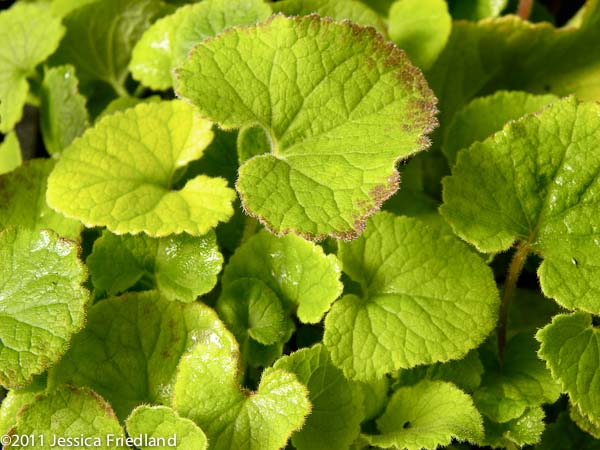
Highly touted by Graham Stuart Thomas, who once referred to it as “a picture of poise and beauty,” this vigorous, clump-forming Campanula hosts a multitude of imposing one-sided spires, packed with creamy white bells from top to bottom. Prominent calyces clasp 2 in. long, nodding blooms, which elegantly illuminate the handsome, long-petioled heart-shaped leaves below.
Blooms July–August
Size: 18" – 2' 0" high x 18" wide.
Hardy to zone 4.
Each $10.75
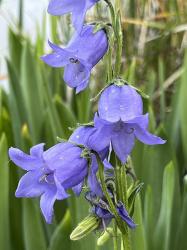
Endemic to the meadows and open woodlands of the Polish Alps and Italian Dolomites plus a region in Norway, this exquisite, seldom offered alpine beauty is named for the unique hairy fringe that extends from nodding porcelain-blue flower tips. Bearded Bellflower’s delicate blooms prance on erect, nearly leafless stems, rising from narrow, lance-shaped pale green foliage. Sustained by a large perennial taproot, the small rough-textured basal rosette begs lime-free, not-so-rich, well- drained soil in the rockery, scree garden or a raised bed, where it may be short-lived but happily reseeds.
Blooms May–July
Size: 8" – 15" high x 8" wide.
Hardy to zone 5.
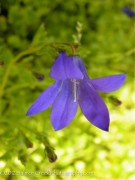
In light of the notion that “new” is not always better, there’s nothing like welcoming back a hard working old friend. Large showy lavender-blue bells flower freely, nodding on graceful 8 in. stems above tidy low mounds of toothed, crisp green foliage. Visually cooling brickwork, small rocks or stone paving in bright sunny spots, this carefree Campanula can be paired with Dianthus ‘Charles Musgrave’ or pink flowering Saponaria x oliviana.
Blooms June–August.
Size: 6" high x 15" wide.
Hardy to zone 5.
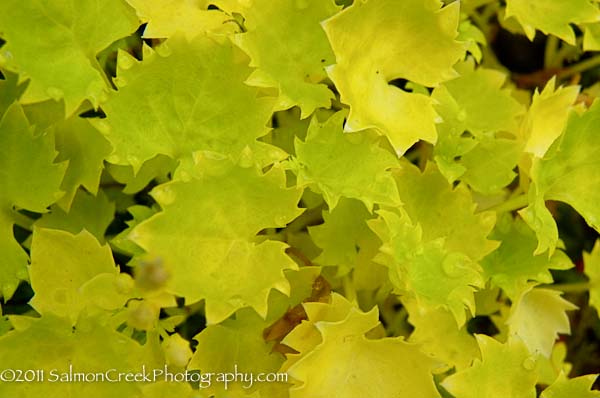
Cool your summer garden with the fresh colors of spring. In partial shade, the vibrant golden foliage and plentiful clear-water blue flowers of ‘Dickson’s Gold’ will literally glow with life. For even more delectable blue, plant with Salvia forsskaolii in the rockery or along a wall.
Blooms June–August.
Size: 6" high x 20" wide.
Hardy to zone 6.
Campanula glomerata ‘Bellefleur White’ (P-2225)
Each $11.25
Indigenous to European meadows and stony calcium-rich outcrops, ‘Bellefleur White’ bears cut-flower-perfect clusters of upward-facing, bell-shaped pure white blossoms on straight stout stems. The orderly compact habit is defined by toothed ovate green leaves that are long-petioled, evergreen and cordate at the base. A favored destination for hummingbirds and butterflies, but not rabbits or deer, this amenable quick-growing perennial casts luminous highlights in the rockery, border frontage, patio pots and troughs.
Blooms June–August
Size: 8" – 12" high x 14" wide.
Hardy to zone 3.
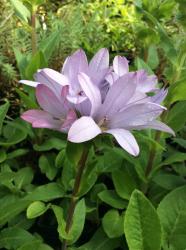
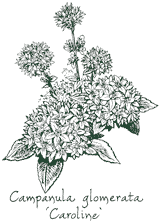
Featured in showy rounded heads, pastel-hued flowers surmount stocky upright stems loosely attired with small sessile leaves. Each long-lasting cluster houses up to 15 small blooms, described by deep mauve tips, aged pale blushed petals and newer more saturated amethyst-pink ones for a distinctive two-toned aspect. Large long-petioled foliage—hairy, toothed, and ovate-shaped—forms a verdant slow-spreading basal clump that relishes even moisture and exhibits more heat tolerance than most glomerata species. Seldom offered and easily cultivated, ‘Caroline’ can be associated with pink-blooming Persicaria ‘Dimity’.
Blooms June–August
Size: 12" – 18" high x 18" wide.
Hardy to zone 3.
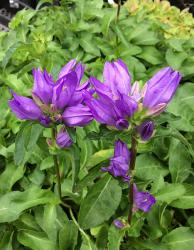
Kudos to the acclaimed Dutch plant breeder Arie Blom for this floriferous midsized charmer. Paying homage to the Norse goddess of love and agriculture, who adored spring, flowers and fairies, ‘Freya’ premiers small, starry, lilac-purple blooms squeezed onto ample rounded clusters. Beneath the lovely long-lasting blossoms that enchant florists, gardeners, butterflies and hummingbirds, a dapper, noninvasive clump-forming rosette sprouts long, toothed somewhat hairy foliage plus multiple upright, strong, well-branched stems. (pp#22,738)
Blooms May–June
Size: 15" – 18" high x 15" – 18" wide.
Hardy to zone 3.
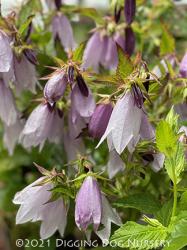
Lauded by bees, hummingbirds and Britain’s Royal Horticultural Society, this hardworking Burpee introduction delivers a scented profusion of delightful, 2 in. pale lilac-silver bells all summer long. Tidy, toothed greenery and leafy semi-upright stems produce up to 30 rich purple buds that create an eye-catching bicolored effect as the clustered iridescent blooms unfurl. Steeped in loveliness, ‘Iridescent Bells’s undemanding deer-resistant habit is perfect for cottage gardens, border frontage and cut arrangements.
Blooms June–August
Size: 18" – 2' 0" high x 18" wide.
Hardy to zone 5.
Large, waxy dark violet-blue flowers hang like lanterns on 3 to 4 ft. stems above glossy basal foliage. We plant this quick colonizing offspring of Campanula takesimana among other vigorous perennials such as Kniphofia pauciflora at the front of the border.
Blooms June–October
Size: 3' 0" – 4' 0" high x 2' 0" wide.
Hardy to zone 5.
Though its name conjures visions of tumbling snow, this sublime and reliable perennial manifests glistening masses of large, bell-shaped snowy white flowers in well-formed clusters. The lovely, long-lasting summertime blooms are bolstered by stout branched stems and tidy, pointed midgreen leaves. Tailor-made for a cottage garden or mixed planting, ‘Avalanche’ becomes a refreshing counterpoint to warm-hued blossoms on a hot afternoon.
Blooms July–September
Size: 3' 0" – 4' 0" high x 2' 0" wide.
Hardy to zone 4.
Campanula lactiflora ‘Loddon Anna’ (P-0044)
Each $12.75
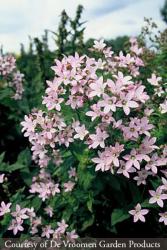
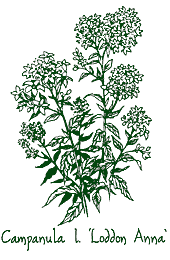
Shapely branching heads of soft pink bellflowers crest firm stems lined in pointed green leaves, and with Boltonia ‘Snowbank’ nearby, create a perfect duet for harmony and support. We love this plant just as much in winter when we pull back the mulch to see its crisp fleshy white buds slumbering away the cold months.
Blooms July–September
Size: 3' 0" – 4' 0" high x 2' 0" wide.
Hardy to zone 4.
You can’t see the foliage for the flowers in this soft puff of pale lavender-blue. We initially encountered this lovely dwarf Blooms of Bressingham selection of C. lactiflora nearly 30 years ago in a garden designed by Beatrix Ferrand, and we’re thrilled to have it available again. Conical panicles are packed with dainty bell-shaped blooms above a compact lush-looking medium green mound. For foliar contrast and a classic combination of blue and white, ‘Pouffe’ can accompany Francoa ramosa.
Blooms July–September
Size: 12" – 15" high x 15" – 18" wide.
Hardy to zone 4.
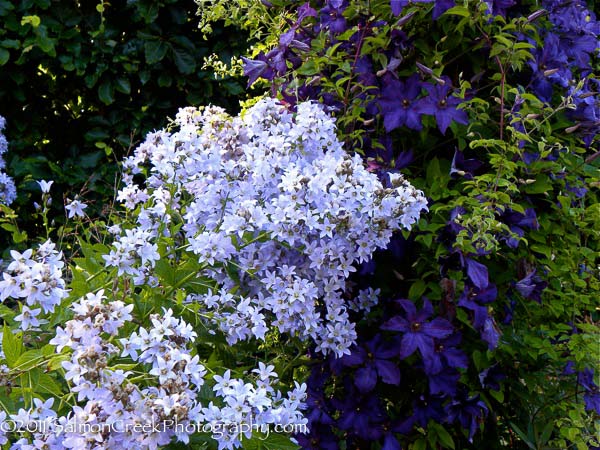
‘Prichard’s Variety’ is really quite a beauty, a classic border plant distinguished by a stylish profile. Abundant large, dome-shaped clusters of vibrant violet-blue flowers, brightened by a white center, crown the staunch branching stalks and rich green leaves. Astrantia ‘Roma’ is a lively companion for this Campanula’s flowers and Achillea ‘Red Velvet’ adds warm red tones.
Blooms mid-July–September
Size: 3' 0" – 4' 0" high x 3' 0" wide.
Hardy to zone 4.
A diminutive leafy mound of soft-looking fresh greenery with toothed margins cushions enchanting outward facing pure white, clustered bell flowers that bees and hummingbirds adore. Selected by revered plantsman Alan Bloom, ‘White Pouffe’s well-groomed compact character can be easily nestled into the frontlines of a border or atop a wall next to Phlox ‘Mini Pearl’ for foliar contrast and pearl-hued blooms.
Blooms June–August
Size: 12" – 15" high x 15" – 18" wide.
Hardy to zone 4.
Campanula latiloba ‘Alba’ (P-0187)
OUT OF PRODUCTION AT THIS TIME
Email me when this plant is available
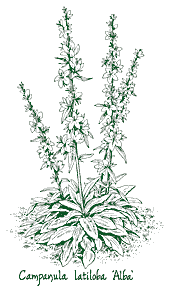
This elegant Campanula forms a tidy mound of deep green evergreen rosettes that hugs the ground. Stiff, flowering stems, in no need of staking, rise midsummer, displaying a multitude of ridged, creamy chartreuse buds. The abundant, snow-white, star-shaped flowers, each accented by three curled white anthers, are perfect for the white garden, especially against Phlox ‘David’.
Blooms July–August.
Size: 2-1/2' high x 2' 0" wide.
Hardy to zone 5.
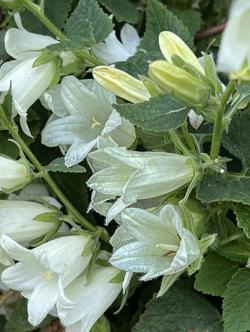
Myriad conical greenish buds plus large, broadly bell-shaped creamy-yellow blooms make an enchanting summer-long appearance along low, leafy arching stems. Composed of fetching heart-shaped foliage with finely-toothed margins plus long petioles, this rarely offered, easy-care cultivar develops a snug slow-spreading bright green clump. Well suited for stone walls, cottage gardens and pathway edging, ‘Mrs. V. Vollenhove’ treasures loose well-drained ordinary garden soil and can accompany other smaller-statured perennials such as Geranium renardii or Veronica ‘Pure Silver’.
Blooms June–mid August
Size: 12" – 18" high x 12" – 18" wide.
Hardy to zone 4.
Campanula portenschlagiana (P-1864)
Each $10.75
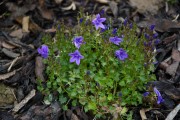
Hailing from Croatia’s Dalmatian Mountains, this natty AGMwinner sets loose a lovely flood of 5-petaled bellstyle violet-blue flowers perched on wiry short branching stems. Small rounded dark green leaves form a closeknit, nearly evergreen mat beneath the long blooming summer display. With charm to spare, Campanula portenschlagiana’s low growing habit tackles heat if there’s adequate moisture, tumbles down slopes or containers and softens any rock’s hard edges.
Blooms June – September
Size: 7" – 12" high x 12" – 2' 0" wide.
Hardy to zone 4.
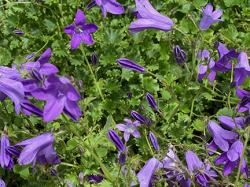
Brimming with pluck and charm, ‘Resholdt’s Variety’s glorious sea of cup-shaped light blue-violet blossoms and darker buds blankets a trim closely woven low-growing mat. The long-stemmed starry upward-facing blooms are nestled atop toothed, triangular deep green leaves, whose petite appearance defies their robust spreading nature. Touted as one of the largest and truest-blue bloomers amongst the species, this free-flowering semievergreen beauty can grace well-drained pathways, rock gardens and containers.
Blooms May–August
Size: 6" – 8" high x 12" – 18" wide.
Hardy to zone 4.
Campanula poscharskyana ‘Alba’ (P-2274)
Each $10.75
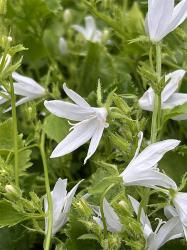
A captivating sparkle of copious star-shaped white blooms illuminates this perky, spreading ground cover. Braving deer, coastal conditions and occasional dry periods, the small heart-shaped jade-green leaves don toothed margins and thin petioles. ′Alba′s winsome semievergreen presence can sprawl amongst pavers, tumble down walls or trail along a pathway, promising easy-care verdant accents and a second bloom when appropriately trimmed.
Blooms June–September
Size: 8" – 10" high x 2' 0" wide.
Hardy to zone 4.
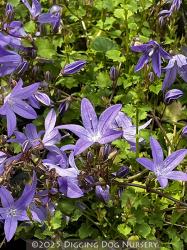
A cascading river of star-shaped blue-violet blooms emanates from this durable, low-to-the-ground gem. Pointy ribbed buds give way to soothing, cool-colored flowers, each highlighted by a subtle white eye, amid good-looking toothed foliage that is darker and more tidy than the species. Tailor-made for spilling over walls or steps, ‘Blue Waterfall’s nearly trouble-free constitution can even handle some drought once established. (pp#13,161)
Blooms June–October
Size: 8" – 10" high x 2' 0" wide.
Hardy to zone 4.
Campanula poscharskyana ‘E. H. Frost’ (P-0046)
Each $10.75
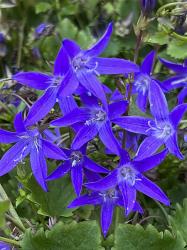
This favorite of ours conjures images of a brilliant sky. The star-shaped blue-violet flowers open to reveal a white center that contrasts sharply with the deep green foliage. In a crevice or trailing over a rock wall with Geum ‘Beech House Apricot’, ‘Stella’s colors will contrast stellarly.
Blooms June – September
Size: 6" – 8" high x 20" wide.
Hardy to zone 4.
Not one person in our garden has passed by this plant without stopping to admire the extraordinary bell-shaped cherry-red flowers, which are neatly edged in white. Onlookers may also notice the unusual ridged buds and long, narrow green calyces. Adorned with pale, purple-spotted throats, the ample-sized, pendulous blooms can grow more than 3 in. long and are especially striking against the backdrop of somewhat triangular, serrated green leaves.
Blooms July–mid-October
Size: 20" – 2' 0" high x 2' 0" wide.
Hardy to zone 5.
Campanula ‘Purple Sensation’ (P-1926)
Each $11.75
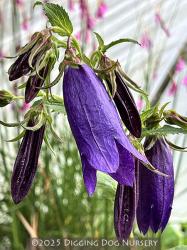
Droves of luscious nearly black buds unfurling pendulous, 3 in. long midnight-purple bells above a compact mounded foundation make ‘Purple Sensation’ a coveted perennial. Introduced by Dutch nurseryman Mark van Kesteren, this sensational easy-care Campanula offers additional enticements: a noninvasive habit, well-branched stalks garbed with attractive heat-tolerant foliage plus fanciful green calyces. (PP#16,027)
Blooms June–August
Size: 2' 0" – 2-1/4' high x 2-1/2' wide.
Hardy to zone 4.
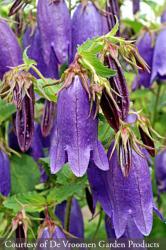
It’s hard to imagine how on earth ‘Kent Bells’ could be improved upon but that’s exactly what happened when this first-rate Campanula punctata and trachelium hybrid was introduced. Not as tall, more compact and slow to spread are all good reasons why ‘Sarastro’ should be invited into your garden, but add glistening 2 in. dark violet-blue bells and it becomes simply indispensable. Named for the Austrian nursery where it originated, this exceptional Bellflower boasts sturdy 20 in. spikes, laden with floral pendants that don’t need staking, and look downright gorgeous alongside yellow-flowering Centaurea ruthenica.
Blooms June–August
Size: 18" – 20" high x 18" – 2' 0" wide.
Hardy to zone 4.
Each $10.75
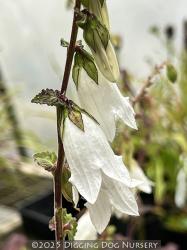
Gracing American gardens since the 1800s, this rarely offered, endangered Campanula fashions an attractive gray-green rosette of crinkled, arrow-shaped leaves, each with a rounded base, a somewhat fuzzy surface and long petioles. The dainty, laden display of flared soft blue bells borne on one-sided, upright racemes belies its rugged character. A sun-tolerant, clumping perennial, Campanula sarmatica’s quiet allure can be admired along a border’s edge or atop a garden wall accompanying Diascia ‘Coral Canyon’.
Blooms July–August
Size: 16" – 20" high x 12" wide.
Hardy to zone 5.
Each $10.75
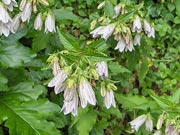
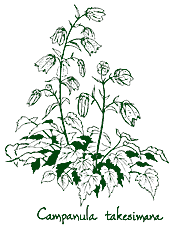
If fairies lived in flowers, they would certainly call this Korean Campanula home. White with hints of lilac on the outside and spotted maroon on the inside, the 2 in. lanternlike flowers lighten even the darkest of days. With reddish stems and large deep green basal foliage, this perennial spreads easily and can be grown in full sun on the coast.
Blooms July–September.
Size: 18" high x 2' 0" & spreading wide.
Hardy to zone 5.
Campanula trachelium var. alba (P-0734)
Each $10.75
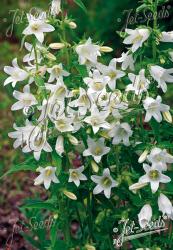
Endemic to the open forests and woodland peripheries of Europe, North Africa and Siberia, this easy-care perennial proffers refreshing good looks. Numerous upright firm leafy stems are dressed with large flared ivory-white bells and pointy green calyces. The endearing floral display lasts all summer above a bristly spring green clump of notched long-petioled nettle-shaped leaves that emerge from a noninvasive woody rootstock. Cheering up borders, cutting gardens and cottage-style plantings, it appreciates light shade, good drainage, moderate moisture and somewhat alkaline soil.
Blooms July–September
Size: 2' 0" – 2-1/2' high x 12" – 15" wide.
Hardy to zone 4.
Campanula trachelium ‘Bernice’ (P-0733)
Each $11.75
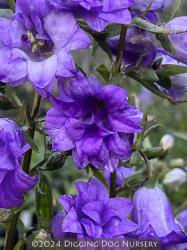
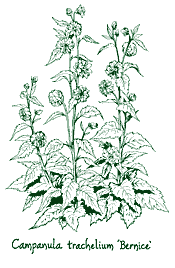
Profusions of showy violet-blue flowers, their delicate layers of petals opening widely, embellish strong leafy stems above a neat mound of jagged-edged basal foliage. An excellent choice for the rock garden, tuck ‘Bernice’ in a crevice with gray-leafed Salvia ‘Bee’s Bliss’ nearby.
Blooms June–July.
Size: 18" high x 15" wide.
Hardy to zone 4.
Cardiocrinum
Himalayan Lily
Cardiocrinum giganteum var. yunnanense (P-1727)
OUT OF PRODUCTION AT THIS TIME
Email me when this plant is available
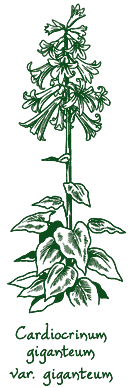
Everything about this fantastic subalpine Chinese native is BIG! Enormous bulbs stockpile their stamina for nearly seven years before launching 10 to 15 ft. tall, hollow black-infused flowering stems, loosely clad in glossy leaves. An elegant gathering of pendulous, 10 in. long creamy white, trumpet-like blooms with reddish purple-streaked throats and a delectable fragrance crowns the energy charged treelike stalks.
Below, handsome thick, heart-shaped foliage that measures about 10 in. across and 18 in. long forges a large green basal rosette. The Giant Himalayan Lily possesses a long lasting dramatic stance, even in autumn, when decorative fruit capsules transmute warm chestnut hues and split open, pouring their countless silky seeds upon the garden.
After flowering the plant sadly perishes, but smaller bulbs ensure an extraordinary encore in a couple of years.
Blooms late June–mid-August.
Size: 15' 0" high x 2' 0" wide.
Hardy to zone 7.
Caryopteris
Bluebeard
Shrouded in a blue mist from midsummer until frost, these woody, shrublike perennials proclaim an Asian heritage and Verbena relations. Aromatic and paired, the deciduous foliage is attired with dense clusters of tantalizing whorled flowers enhanced by showy extended stamens. An excellent choice for a shrubby bed, mixed border or open bank, their cool colors complement the warmer tones of late season blooms. Prized by bees and butterflies, sun-loving Caryopteris tolerates some drought and demands good drainage.
Each $11.25
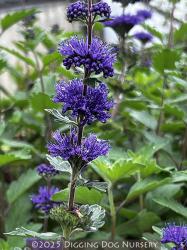
This shrubby perennial is valued for its ability to handle a dry site, but definitely proves itself indispensable when masses of its deep blue-violet flowers put on a spectacular show. Enveloping stiff upright stems, the richly colored blooms are long lasting in the garden and in arrangements as well. Handsome, grayish green felted leaves emit a pleasing medicinal scent as they cloak Common Bluebeard’s looser, more open profile.
Blooms mid-August–October
Size: 3' 0" – 5' 0" high x 4' 0" wide.
Hardy to zone 7.
Centaurea
Knapweed
Centaurea’s heritage extends all the way back to ancient Greek mythology when Achilles’s wise teacher, Chiron the Centaur was wounded by one of Hercules’ poisoned arrows and subsequently cured by this herb’s miraculous healing powers.
Equally at home in a present day border or a more naturalized setting, our hardy undemanding selections paint a bright picture inside as well. The long lasting boisterous blooms are celebrated cut flowers, bringing high-spirited accents to both fresh and dried arrangements.
Appreciative of well draining “sweet” soil, the ever amenable Knapweed withstands some drought, but not wet, wintertime feet.
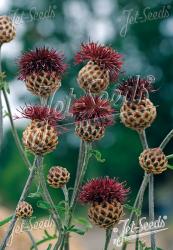
Milling about the mountainous meadows of Europe’s Carpathian Range, this garden rarity spotlights large ruby red thistle-styled blooms bolstered by impressively tall sturdy stems. Even before the marvelous flowers appear, intricately detailed buds with brown-tipped green scales and curvy white spines beg a closer glance. A delicate-looking rosette of long feathery leaves—silver-gray and narrowly cut—completes the picture, while yellow blooming Centaurea ruthenica makes an ideal companion.
Blooms June – August.
Size: 4' 0" high x 2' 0" wide.
Hardy to zone 5.
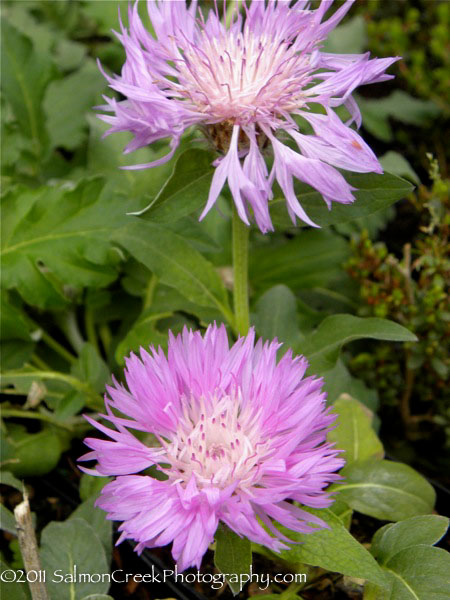
Cradled by silvery, paper-thin bracts, a vivacious summertime showing of deep rose-pink thistlelike blooms with pale centers promises a fall encore when deadheaded regularly.
Long green leaves—deeply divided, lobed and powdery white beneath—line stiff-backed stems, bolstering the fragrant high energy performance.
A magnet for butterflies and gardeners alike, this carefree Centaurea exhibits a compact, not-so-tall profile that can be featured atop a wall or near the border’s front, obliges dry soils and keeps us coming back well after the flowers have faded to relish its long lasting, decorative seed heads.
Blooms July–August.
Size: 2' 0" high x 18" wide.
Hardy to zone 4.
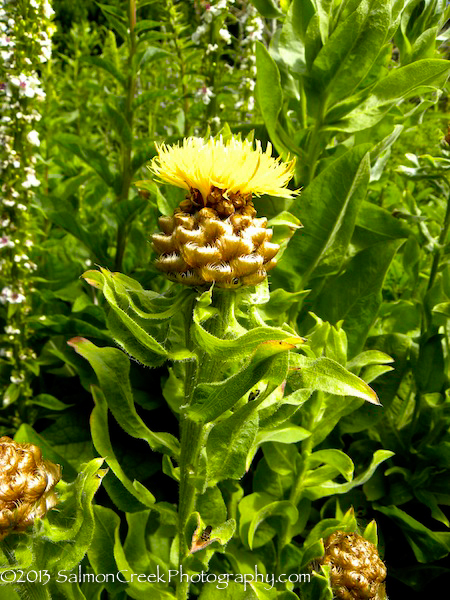
An overgrown, sun-struck relative of the Bachelor Button, this “big-headed” native of the Caucasus Mountains has so many good qualities you’ll soon be inviting it into your garden. A medium green, rowdy mass of oversized, wavy-edged lanceolate leaves attached to stout stems gives way to intriguing, rust-colored buds as big as a chicken’s egg. Scaled by papery bracts, the bud’s rotund profile opens to offer a large, bright yellow thistle, a cheerful mop of thread-like petals bursting with sunshine and color. Back this easy-to-grow cut flower with Aconitum ‘Arendsii’ and surround it with Nepeta stewartiana.
Blooms late July–mid-September
Size: 3' 0" – 4' 0" high x 2-1/2' wide.
Hardy to zone 4.
Centaurea montana ‘Black Sprite’ (P-1928)
Each $11.50
Coveted by florists, bees and butterflies, the silken starburst of finely fringed blackberry-colored petals and embroidered dark buds creates an arresting contrast against silver-haired, gray-green lanceolate foliage. ‘Black Sprite’s exotic, long-blooming tubular flowers sojourn on upright stems above a low growing leafy mound that tolerates dry conditions once established and prefers good drainage plus slightly alkaline soil as well as a periodic cutback. (pp #23,250)
Blooms May–June
Size: 18" high x 18" – 2' 0" wide.
Hardy to zone 3.
Centaurea montana ‘Jordy’ (P-1797)
Each $11.50
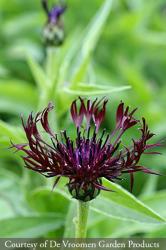
Ringed with spidery ultra-fringed tubular florets, the dark-as-midnight blooms are presented singularly, strutting sumptuous reddish purple shades on tall staunch stems. Black embroidered buds, intriguing seed heads and silver felted new growth further enhance the tidy clump of broadly lanceolate green leaves that sport minute pearly hairs. A fan of lean chalky sites, this fanciful bloomer appreciates periodic pruning and works best as a filler in a Mediterranean planting, cottage garden or a naturalized setting, where it will bring on the bees, butterflies and other admirers.
Blooms May–June.
Size: 18" high x 18" – 2' 0" wide.
Hardy to zone 3.
Centaurea pulcherrima (P-1876)
Each $10.75
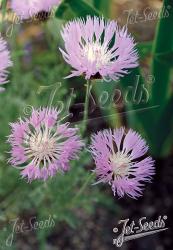
Touted as one of the prettiest species of the genus, Centaurea pulcherrima celebrates brilliant rose-colored flowers with silvery yellow bracts unfurling from large papery buds. This rarely offered robust perennial hosts handsome narrow pinnate grayish green leaves with hairy white undersides. Endemic to the Caucasus Mountains, Pink Bachelor Button makes a sterling prospect for stone walls, sun bathed rock gardens or even a bouquet.
Blooms June–August
Size: 16" high x 2' 0" wide.
Hardy to zone 4.
“A border flower of the highest merit,” is how British horticulturist, William Robinson once described this awe-inspiring Centaurea, and we couldn’t agree more! Crowning long straight green stems, the fluffy thistle-style heads in unique pale citron yellows and tissue-thin buff-colored bracts will attract more than a few admirers. These ample-sized, sublime-for-cutting blooms heighten a graceful ferny pedestal of rich green pointed leaves with gray undersides, narrow silhouettes and a refined countenance. Appreciative of adequately draining soil, the ever amenable Knapweed withstands some drought, but not wet winter feet.
Blooms July–September
Size: 3' 0" – 4' 0" high x 2' 0" wide.
Hardy to zone 5.
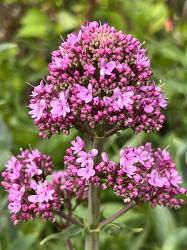
From the ruins of Europe and the chalky cliffs of Dover to your garden’s refuge, this age-old Mediterranean perennial is second-to-none for long, showy summertime bloom. Clothed with glaucous and paired, stemless blue-green leaves that Sicilians once savored in their salads, the handsome bushy clump entices us with minute, fragrant deep carmine-red florets densely arranged in domed, cut-flower-perfect terminal clusters. Whether it’s situated on slopes, stone walls, terrace cracks or borders, the boldly colored Red Valerian can endure most conditions except damp shade, and especially thrives in alkaline soil with little or moderate moisture. A good pruning ensures a repeat bloom, maintains a pleasing shape and prevents self-seeding.
Blooms June–October
Size: 2' 0" – 3' 0" high x 2' 0" wide.
Hardy to zone 5.
Cephalaria
The most garden-worthy plants of this versatile genus, which includes 65 species of annuals, biennials and perennials, all bearing pincushion flower heads, are valued for their stature and distinctively textured foliage. Amenable and undemanding perennials with a graceful air, our selections work equally well as specimens or as a swath meandering through the landscape.
Cephalaria galpiniana (P-1749)
Each $11.25
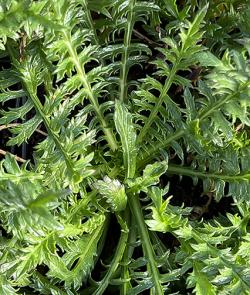
Cephalaria galpiniana is unique among other species in the genus for its attractive, ferny green basal mound comprised of long, narrow ultra-chiseled toothed leaves and succulent stems. Buoyant creamy yellow pincushion-styled flowers are presented on supple 18 in. green stalks for a carefree summer showing. Smaller statured than its towering cousin, Cephalaria gigantea, this seldom offered perennial can be situated closer to the frontlines, where its relaxed stance and easily melded colors effectively offset broad or gray foliage and bolder-hued flowers.
Blooms June–August.
Size: 18" – 2' 0" high x 12" – 15" wide.
Hardy to zone 7.
Each $11.25
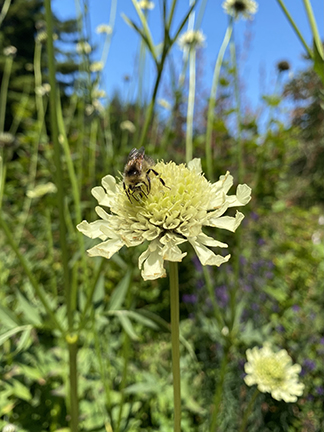
This large long-lived perennial has flat Scabiosa-like primrose-yellow flowers supported by wiry striped stems and a basal clump of pinnately lobed dark green foliage. A cinch to cultivate, Cephalaria gigantea projects a compelling, yet lighthearted presence in any garden and when given room to grow, we guarantee you’ll be impressed.
Blooms June–August
Size: 6' 0" high x 4' 0" wide.
Hardy to zone 4.
Cirsium
Giant Thistle
Beckoning bees, butterflies and birds, our intensely colored cut-flower-perfect Cirsium selections are the most coveted of all garden-worthy thistles.
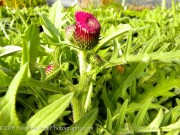
Elevated on upright, branched leafy stems, the densely packed dark crimson flowers have a tidy symmetrical appearance. Prickly, narrow cut green leaves form a slow spreading clump that appreciates moisture and works well in a natural-style planting, especially when associated with other opulent-blooming perennials like Papaver ‘Patty’s Plum’ or Astrantia ‘Moulin Rouge’.
Blooms July–September
Size: 4' 0" high x 20" – 2' 0" wide.
Hardy to zone 4.
While calling this chipper pincushion-like flower ‘blue’ is a bit of a stretch, its saturated heather-purple color is sure to please. The vivid nectar-rich blossoms are a pollinator’s delight, surmounting upright slender stems that rise from narrow green leaves laced with a subtle silver sheen.
Blooms July–September
Size: 4' 0" high x 20" – 2' 0" wide.
Hardy to zone 4.
Codonopsis
Asian Bellflower
Codonopsis clematidea (P-1173)
Each $11.00
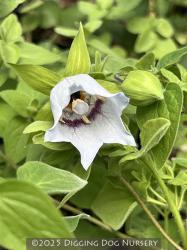
This twining, dainty member of the Campanula family reveals a quiet beauty and hidden treasures. Inside each nodding, urn-shaped china blue flower is a remarkable tapestry of color: dark purple veins and maroon bands with orange at the base. Appreciative of a cool, well drained site, the upright gray-green clump eventually trails, and should be planted in a raised position above a wall or along garden steps so that you can admire the cloistered bloom colors.
Blooms June–July
Size: 20" high x 20" wide.
Hardy to zone 4.
Coreopsis
Tickseed
The Coreopsis we offer are perennials. They share some characteristics with their annual cousins: they are dependable, easy to work with, and make a quick impact. Though they often play a supporting role, Coreopsis are performers you’ll remember when the show’s over, for foliage as much as for stellar flowers.
Coreopsis ‘Créme Brulée’ (P-1251)
OUT OF PRODUCTION AT THIS TIME
Email me when this plant is available
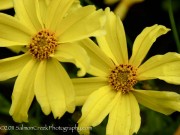
If Créme Brulée is your dessert of choice, consider satisfying your sweet tooth in a less caloric but equally delightful way. Originally discovered in Lois Woodhull’s Long Island garden, this new Blooms of Bressingham hybrid is parented by Coreopsis grandiflora and Coreopsis ‘Moonbeam’.
Neat ferny mounds serve as a dark green, threadleaf foil for large, butter yellow, luminous flowers. Delicately notched at each petal tip, the perky, long blooming daisies not only top the foliage but line the robust stems. To savor an array of color and texture, clump forming ‘Créme Brulée’ can be grouped with Verbascum ‘Flush of White’ and Eryngium ‘Sapphire Blue’. (PPAF)
Blooms late June–September.
Size: 20" high x 2' 0" – 2-1/2' wide.
Hardy to zone 5.
OUT OF PRODUCTION AT THIS TIME
Email me when this plant is available
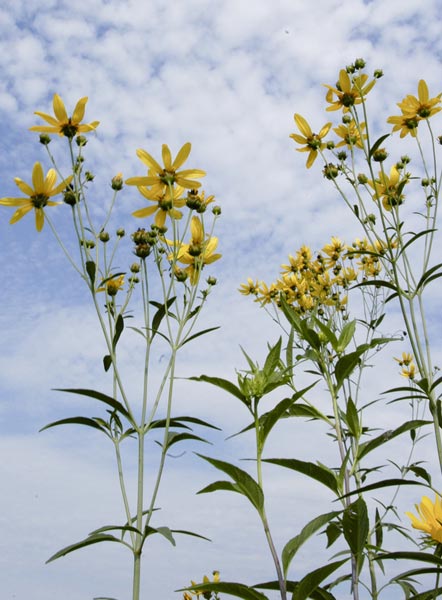
This lofty North American native yields a sea of dark-centered yellow daisies dancing atop strong, upright stems, which branch high up and impart an airy stature. Tall Tickseed is easy to grow and is most at home in a meadowlike setting, juxtaposed with the blue blades of Panicum ‘Cloud Nine’ and purple flowered Aster turbinellus.
Blooms August–September.
Size: 7' 0" high x 2' 0" wide.
Hardy to zone 4.
Coreopsis tripteris ‘Gold Standard’ (P-1980)
Each $11.50
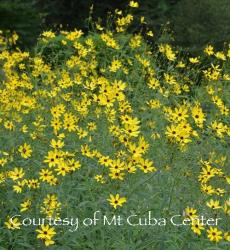
A new compact selection discovered in Alabama by the Mt. Cuba Center, this lofty North American native yields a sea of solitary, dark-centered yellow daisies with eight round-tipped rays atop strong erect stems, which branch high up and impart an airy stature. Trim, anise-scented green leaves, featuring three narrow lance-shaped segments, garb ‘Gold Standard’s disease-resistant cold-hardy bearing. Easily grown Tall Tickseed is most at home in a meadow-like setting, juxtaposed with the grayish green blades of Panicum ‘Rehbraun’ and purple-flowering Aster turbinellus.
Blooms July–September
Size: 4' 0" – 6' 0" high x 2' 0" – 3' 0" wide.
Hardy to zone 3.
Coreopsis verticillata ‘Moonbeam’ (P-0051)
Each $11.50
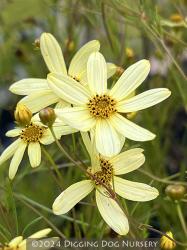
A year-round delight, ‘Moonbeam’ emerges in spring as an almost mossy green mat; finely cut leaves evolve into fluffy foliage that supports billows of pale yellow-green star bursts. This unusual chartreuse complements almost any other color, though our favorite combination is Penstemon ‘Alice Hindley’ or Miscanthus ‘Rigoletto’. After its long show, the rust-tinted seed heads remain through fall. Utilized as a ground cover in the rock garden or a border—sturdy ‘Moonbeam’ does it all.
Blooms June–September
Size: 18" high x 20" wide.
Hardy to zone 4.
Coreopsis verticillata ‘Zagreb’ (P-0052)
Each $11.50
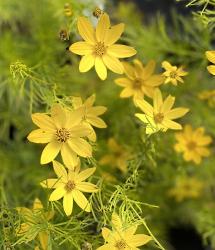
If you’ve tried some of the new Coreopsis introductions, but long for a blast from the past, you may be pleased to rediscover this tough-guy Coreopsis, whose finely cut, dense architectural form looks attractive even before the long lasting blooms appear. Dissected slender green leaves plus sturdy upright branching stems bolster a cheerful profusion of golden yellow daisies. Versatile, dependable and drought resilient, ‘Zagreb’ makes a colorful highly textured addition to the foreground, especially when flanked by Sidalcea ‘Elsie Heugh’.
Blooms July–September.
Size: 18" – 2' 0" high x 15" wide.
Hardy to zone 5.
While its name does little to conjure a pleasing image, this demure perennial's charm is easily conveyed. Populating the cool, moist streamsides and woodlands of Japan and northern China and closely akin to the Primula genus, Cortusa makes a pretty detail in a shady rock garden.
The dainty umbels are poised on 9 in. stems, spotlighting pendant, bell-shaped rosy purple flowers with white-ringed centers above a low growing, downy soft clump of broadly rounded, incised leaves.
Blooms April–June
Size: 9" high x 10" wide.
Hardy to zone 4.
Corydalis
The closest relatives of this striking genus are the bleeding hearts. The Greek name, meaning “crested lark,” alludes to the elegant bird-like appearance of the flowers, which grow in racemes among ferny foliage.
Corydalis ‘Blackberry Wine’ (P-0923)
Each $11.75
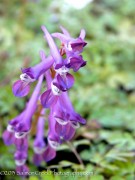
Drink in the multitudes of pendulous, white-flecked flowers adorning this sweetly perfumed and richly hued, quick-to-establish Corydalis. The blooms really are the color of blackberry wine, and set against fern-like blue-green leaves, impart a heady aspect to the garden, especially when contrasted with the golden blades of Hakonechloa ‘All Gold’.
Blooms May–November
Size: 10" high x 18" wide.
Hardy to zone 5.
Exalted for its taller, more robust and long-flowering visage, this exciting new Corydalis flexuosa and Corydalis elata cross was bred in France and recently introduced in England. Embodying the best qualities of both parents, ‘Blue Line’s vigorous finely cut foundation maintains a reliable summer presence, highlighting a honey-scented flood of white-throated, deep metallic-blue blossoms on tall reddish-tinted stems. The eye-catching flowers keep coming from spring ’til fall and create quite a show alongside Begonia ‘Alba’ and flanked by bold-leafed Rodgersia ‘Braunlaub’.
Blooms May–September
Size: 15" high x 15" wide.
Hardy to zone 4.
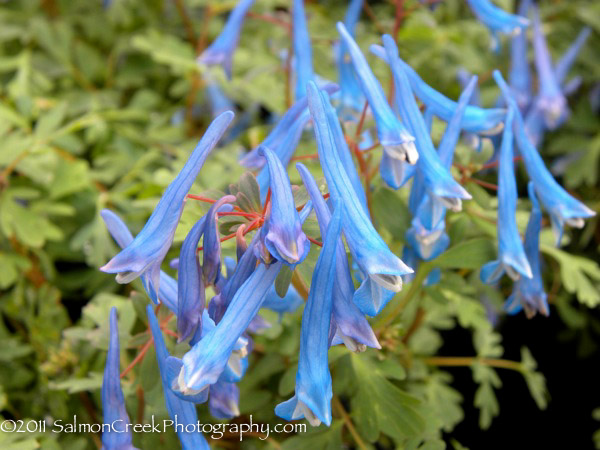
Keenly selected on a collecting trip to Sichuan, China by Dan Hinkley, ‘Blue Heron’ heralds the largest, darkest, richly blue blooms of all our Corydalis offerings. Finely divided blue-green foliage becomes a gossamer-like backdrop for the fragrant sapphire-blue flowers, whose extraordinary cool colors can be enjoyed near fellow shade dweller Epimedium ‘Frohnleiten’.
Blooms April–June
Size: 9" high x 12" wide.
Hardy to zone 6.
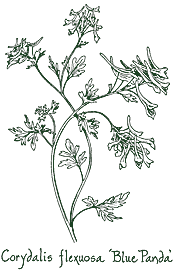
Long after other Corydalis have gone dormant for the summer, ‘Blue Panda’ will brighten your garden with vibrant, electric blue blooms above a tidy mound of filigree textured foliage. Tuck it under the upright, vigorous stems of Euphorbia x robbiae and the white flowering Viburnum ‘Chiquita’ for a striking vignette.
Blooms May–November.
Size: 10" high x 18" wide.
Hardy to zone 4.
Corydalis flexuosa ‘China Blue’ (P-0398)
Each $11.75
Corydalis flexuosa ‘Pere David’ (P-0450)
Each $11.75
Corydalis flexuosa ‘Porcelain Blue’ (P-2073)
Each $11.75
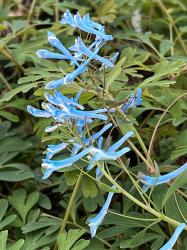
We have Hillier Nursery, a venerated UK mainstay, to thank for this valiant, repeat blooming Corydalis. Selected from a group of flexuosa seedlings, it hosts dazzling, large tubular flowers saturated with vibrant frosty-blue shades atop distinctive, fine-hewn, blue-green foliage that dons bronze tones. ‘Porcelain Blue’ provides additional enticements: the somewhat loosely arranged, easy-care clump doesn’t undergo a summer dormancy, plus its show-stopping sweet smelling racemes appear in spring and again in late summer, enchanting bees, hummingbirds and plant connoisseurs alike.
Blooms April–June & September
Size: 12" high x 18" wide.
Hardy to zone 5.
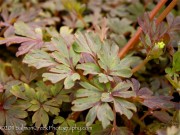
With an intriguing royal purple hue infusing each leaf, this low clumping species is the earliest blooming Corydalis we offer, bearing smoky periwinkle-blue flowers throughout the winter in our garden. The lovely leaf color holds best in partial shade.
Blooms November–May.
Size: 10" high x 18" wide.
Hardy to zone 4.
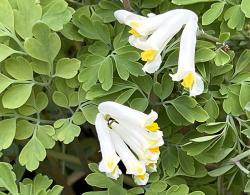
Native to rocky woods and naturalized upon old walls in Europe, this is one of the most beautiful foil plants for a shady garden. The lacy bluish green foliage and creamy-white flowers, enhanced by green lips and yellow throats, add a delicate touch to crevices or steps. For more splendor, we combine this almost year-round bloomer with Campanula ‘Blue Waterfall’ and Brunnera ‘Hadspen Cream’.
Blooms June–October
Size: 18" high x 18" wide.
Hardy to zone 5.
Crambe
Giant Seakale
Coined from the Greek word for “cabbage,” this Brassica-related genus is relatively small, including about 20 annual and perennial species that bear dense racemes composed of minute flowers atop mostly leafless stems. Our European Crambe selections combine a commanding garden-worthy presence with easy-care sensibility.
Each $12.50
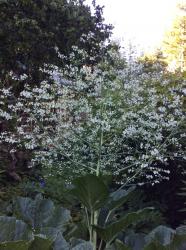
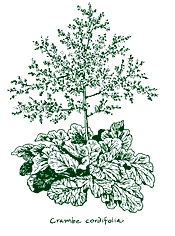
As it translates, “cabbage-style, heart-shaped foliage” is accurate but misses the big picture, and we mean big. Handsome, crisp green leaves, each measuring 12 to 14 in. long and wide, form a 2 to 3 ft. mound. A single stem, nearly 3 ft. tall, hosts a giant spray of tiny flowers, a loose haze of filigree in Paleolithic proportions. When cut, the fragrant blossom works like Baby’s Breath. Dynamic as a specimen or background plant, Crambe adds high drama, even humor, to any situation.
Blooms June–July
Size: 3' 0" high x 2' 0" – 3' 0" wide.
Hardy to zone 5.
Each $12.50
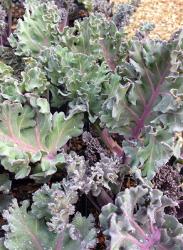
Mentioned in Thomas Jefferson’s 1809 Garden Book and frequently served for dinner at Britain’s Royal Pavilion during the late 1700s, this evergreen European seaside native is both a culinary and ornamental delight. The textural powdery-blue mound of thick, waxen and ruffled leaves gives way to stout branching stems topped by ample flower heads with myriad small, creamy-white blooms. Flaunting an AGM, a wondrous long-lived persona and savory nut-flavored notes, Sea Kale counts cabbage among its kin, detests root disturbance and favors sun as well as good drainage plus a rich sandy loam. Easily grown Crambe maritima braves poor soil, dry sites and windy coastal conditions.
Blooms June–July
Size: 2-1/2' – 3' 0" high x 2-1/2' wide.
Hardy to zone 5.
Crocosmia
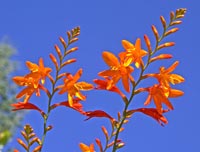
Montbretia
Coveted by florists, these brightly colored flowers unfold along the length of tall arching spikes, which emerge from handsome clumps of sword-like foliage. If given well-drained soil and divided every 2 to 3 years, this fountain-shaped plant will continue to pour spectacular color into your garden for a long, long time.
With sword-shaped henna-imbued green blades and richly tinted burnt reddish umber blooms, this floriferous Crocosmia celebrates salsa-style colors. The narrow-leafed elegantly arching clump gives way to dark mahogany buds and lavish quantities of starry, open-faced yellow-eyed flowers. Locate near companions such as Kniphofia ‘Alcazar’ and Geum ‘Rubin’ and enjoy the sizzle.
Blooms August–September
Size: 2' 0" high x 18" wide.
Hardy to zone 6.
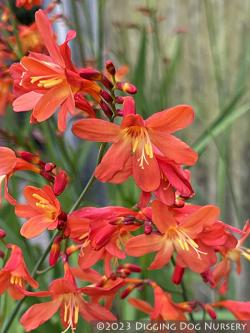
Dainty sprays of carmine-colored flowers are a pleasing counterpoint to upright green foliage and bronzy-green stems. A red-streaked yellow throat centers the open, pale tomato-red face, while the outside of the petal is flushed with a richer red. The real jewel of ‘Carmine Brilliant’s crown, however, may be the stunning flower buds, which have a mustard-hued band, a deep brick-red tip and crimson-purple calyces.
Blooms August–September
Size: 20" – 2' 0" high x 2' 0" wide.
Hardy to zone 6.
Crocosmia x crocosmiiflora ‘Columbus’ (P-2275)
Each $11.75
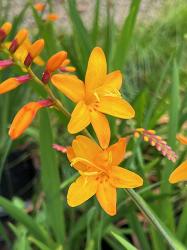
Originally raised by Dutch nurseryman Jac M. van Dijk and introduced in 1999, this robust AGM recipient is just as compelling in bud as in bloom. The arching, sturdy dark stems present myriad gold-tipped dusky-violet buds unfurling a clustered radiant spray of large apricot-yellow flowers, each with a distinctive crimson-streaked central ring. Included in Gardens Illustrated’s best 10 Monbretia to-grow list, ′Columbus′s upright medium green blades and vibrant flowers can hobnob amongst Helenium ‘Kanaria’ and Deschampsia ‘Goldtau’ for a late season gold-soaked soiree.
Blooms August–September
Size: 2-1/2' high x 18" wide.
Hardy to zone 6.
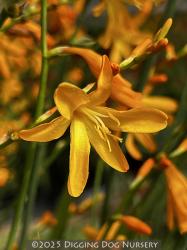
Lifted above upright, narrow apple-green blades on sturdy branched green stems, a plethora of trumpet-shaped sunny yellow blooms with cream-colored throats radiate good cheer for gardeners and hummingbirds alike. ‘Honey Angels’ is a compact well-groomed Crocosmia aurea and Crocosmia pottsii hybrid that can be staged amongst Agapanthus ‘Back in Black’ and Aster ‘Prince’ for a lively late season tango.
Blooms August–September
Size: 18" – 2' 0" high x 18" wide.
Hardy to zone 6.
This Crocosmia is full of promise as vivid orange buds, nestled in dark calyxes, begin to open. A vigorous clump of olive-green blades, warmly tinted in bronze hues, gives way to sprays of large, outfacing flowers, colored a sherbety yellow-orange on the inside and backed with deeper peach shades. Position beside blue blooming Aconitum and relish the spirited union of complementary colors.
Blooms August – September.
Size: 3-1/4' high x 2' 0" – 2-1/2' wide.
Hardy to zone 6.
Crocosmia ‘Emberglow’ (P-0328)
Each $11.75
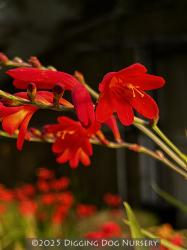
This dazzling Alan Bloom creation is applauded for its sultry presentation of deep scarlet star-shaped blooms, which glow like embers on artfully arching stems. Flowering a little later and longer than ‘Lucifer’ with tidy, more compact green pleated foliage, ‘Emberglow’s nodding tubular flowers deliver flashy accents to Aster ‘Mönch’ and Helenium ‘Sahin’s Early Flowerer’, while the showy fruiting stalks are prized in cut arrangements.
Blooms August–September
Size: 2' 0" – 3' 0" high x 18" wide.
Hardy to zone 6.
Crocosmia ‘Emily McKenzie’ (P-0702)
Each $11.75
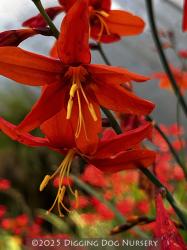
Above a sea of bronze-toned foliage, dark purple calyxes highlight ‘Emily Mckenzie’s wide-open, yellowish orange flowers, and dramatic maroon markings decorate their pale orange centers. To enhance the stunning carousel of color, pair this robust beauty with Aster ‘Bill’s Big Blue’.
Blooms August–September.
Size: 2-1/2' high x 2' 0" wide.
Hardy to zone 6.
Back in 1905, Dutch plantsman E. H. Krelage developed this aptly named Crocosmia that premiers medium-sized yet copious deep crimson-scarlet blooms with tangerine highlights, yellow throats and maroon calyces. Dark buds unfurl the dazzling display above narrow, straight sword-shaped green leaves, and wield a red-hot union when accompanying Aconitum ‘Arendsii’ or Eryngium ‘Blue Glitter’.
Blooms August– September
Size: 2' 0" high x 18" wide.
Hardy to zone 6.
Crocosmia ‘Harlequin’ (P-1879)
Each $11.75
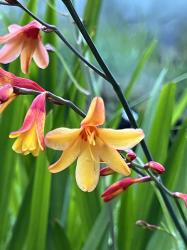
The arching purple-imbued stems support a gorgeous presentation of bicolored blooms defined by orange inner throats and beaming yellow petals with red and marigold-colored flip sides. Yielding upright lance-shaped dark green leaves, this prismatic newly introduced Crocosmia cools down when lodged next to blue or violet-hued flowering plants such as Nepeta ‘Kit Cat’ and Lavandula ‘Blue River’.
Blooms August–September
Size: 2' 0" high x 18" wide.
Hardy to zone 6.
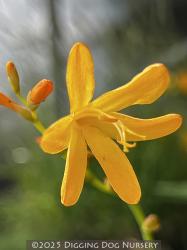
Dutch nurseryman Willem Heemskerk introduced this blithe hummingbird darling in 2000, though some speculate it was originally raised by Paul Boots. Upright grass-green blades and graceful arching stems boost panicles of starry, flat-faced canary-yellow blooms with wide-spaced petals, paler centers and golden flip sides. Ideal for a border or container, ‘John Boots’s ebullient blossoms and burnt orange seed heads make stellar additions to cut arrangements.
Blooms August–September
Size: 2' 0" high x 18" wide.
Hardy to zone 6.
Demure, lusciously colored apricot blossoms, with small dark red streaks in their throats and bright green calyxes line the branched flowering stems of the same color. Adorning upright, green Iris-like foliage, the long lasting blooms arrive late in summer and beckon another glance alongside Aster ‘Blue Danube’.
Blooms August–September.
Size: 3' 0" high x 2' 0" wide.
Hardy to zone 6.
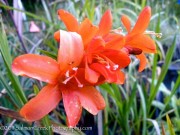
Relatively new on the scene, ‘Limpopo’ embellishes the late summer landscape as its tight clusters of delightful, wide-open, coral-hued flowers with sunlit-yellow throats unfurl. Pointed green blades form a dashing upright clump that offsets the uniquely colored blooms and their arching bronze-toned stems.
Blooms August–September
Size: 2-3/4' high x 18" wide.
Hardy to zone 6.
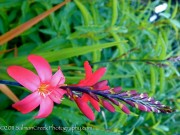
We have David Tristram to thank for this richly colored, long blooming Crocosmia. Each stunning flower bud features a crimson-purple calyx, a mustard-hued band and a deep red tip. Along graceful stems, the easily viewed, outward-facing, tomato-red blooms brightened by sunny yellow throats are spaced just right to heighten the fervid, floral spectacle.
Easily tucked into a small-sized garden in front of Salvia ‘Black and Blue’, ‘Little Redhead’ spices things up, while its composed, bladed greenery keeps a lower profile than our other Crocosmia offerings.
Blooms August–early October.
Size: 18" – 2' 0" high x 2' 0" wide.
Hardy to zone 6.
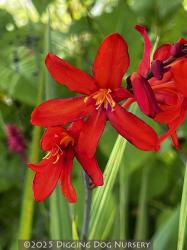
The fiery fountain of open blooms, borne in a bold upright fashion, along a single side of its wiry purple-tinted stem, will burn this excellent cut flower into your heart. A valiant stand of stiffly pleated, sword-like green foliage tempers the hot display. Give ‘Lucifer’ his due by showing off his devilishly fine color next to Campanula lactiflora ‘Prichard’s Variety’.
Blooms August–September
Size: 4' 0" – 4-1/2' high x 2-1/2' – 3' 0" wide.
Hardy to zone 6.
Bred in 1887 by French nurseryman and hybridizer Victor Lemoine, ‘Météore’ showers the garden with large warm-hued flowers. Broad rounded petals have red-streaked, burnt orange backsides, while a cinnabar throat and cozy orange and amber colors enhance the interior. And if the abundant lively blooms aren’t reason enough to usher this Crocosmia into your garden, there’s more—tangerine-tinted buds, purple calyxes and a verdant clump of sword-shaped upright leaves.
Blooms August – September.
Size: 2' 0" – 2-1/4' high x 18" wide.
Hardy to zone 0.
Hailing from the Dutch nursery Langedijk, this floriferous hybrid Croscosmia closely resembles Crocosmia masoniorum more so than its other parent, Crocosmia paniculata. Blade-like ribbed green leaves forge a tasteful forest, unleashing remarkable upturned sprays of toasty yellow-throated red blooms perched on narrow arching stems. A top-notch addition to cottage gardens, borders or coastal plantings, ‘Mistral’s flowers bewitch the butterflies and emblazon perennials such as Dahlia ‘Bishop Of York’, Monarda ‘Jacob Cline’ and Helenium ‘Zimbelstern’.
Blooms August–September
Size: 2' 0" – 3' 0" high x 18" wide.
Hardy to zone 6.
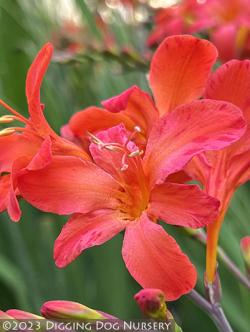
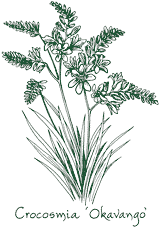
A fantastic relatively new Bob Brown introduction, this distinctive Crocosmia bears the name of its native haunts, South Africa‘s Okavango River. Big broad green blades launch a flashy display of large peachy orange flowers, reminiscent of summertime fruit, crowded together on staunch stems. In addition to their luscious hue, the easily enjoyed outward facing blooms feature broad rounded petals, yellowish throats and extended stamens. ‘Okavango’ can be planted near Agapanthus ‘Storm Cloud’ for a lively floral presentation.
Blooms August–September.
Size: 2' 0" – 3' 0" high x 18" wide.
Hardy to zone 6.
Crocosmia ‘Pauls Best Yellow’ (P-2075)
Each $11.75
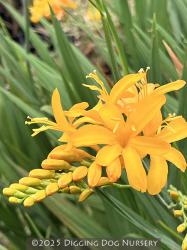
A recent Ken Ridgely introduction, this robust yet well-mannered cultivar sends forth a tall verdurous stand of fetching fresh green foliar blades and bright blooms. Outward-facing egg-yolk yellow flowers are arranged Freesia-style on gorgeous lengthy trusses. Claiming the coveted RHS Garden Merit Award, ‘Paul’s Best Yellow’ can tango with Agapanthus ‘Storm Cloud’ in the perennial border, be added en masse to a hot-colored planting scheme or bedeck a vase.
Blooms August–September
Size: 2-1/2' – 3-1/4' high x 18" wide.
Hardy to zone 6.
Each $11.75
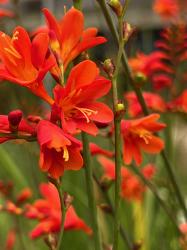
Heralding a passionate array of toasty colors, this smaller sized cultivar was selected by British gardener John Fitt and introduced in 1929. Hearty, lance-shaped green leaves support a multitude of sizzling salsa-red, star-styled blooms, which showcase luminous yellow centers fringed with darker tangerine shades.
Blooms August – September.
Size: 2' 0" high x 18" wide.
Hardy to zone 6.
Crocosmia ‘Solfaterre’ (P-0516)
Each $11.75
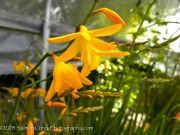
This selection will make your mouth water with smoky-bronze foliage, butter-yellow flowers and dark chocolate calyces. The strong upright leaves add a linear dimension to the border, and contrast beautifully with finer textured plants such as Salvia reptans.
Blooms August–September
Size: 18" – 2' 0" high x 18" wide.
Hardy to zone 6.
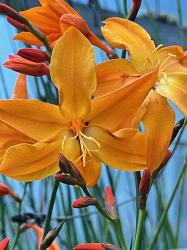
Evoking a brilliant night sky, this 1912 AGM-winning introduction by George Davidson is still considered one of the best in the genus. Handsome pleated sword-like green foliage launches burnt orange buds that unfurl extralarge star-shaped blooms nestled within clay-colored calyces. Cherished by hummingbirds and butterflies, the slightly nodding, 3 ½ in. wide flowers present dusky orange hues on the flip sides, soft orange interiors and cream-colored throats. Persistent bird-friendly seedpods add late season interest.
Blooms August–September
Size: 2-1/2' – 3' 0" high x 2' 0" wide.
Hardy to zone 6.
Deemed one of the best sunshine-colored Crocosmias, ‘Voyager’ boasts large 2-½ in. flat-faced bright yellow flowers whose slightly rounded petals curl back with age. The positively cheerful blooms ride a green sea of vigorous upstanding blades that are ideally sized for a border’s midsection.
Blooms August – September.
Size: 2' 0" – 2-1/2' high x 18" wide.
Hardy to zone 6.
Crocosmia ‘Walberton Orange’ (P-1566)
Each $11.75
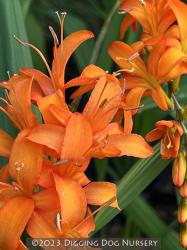
A probable Crocosmia masoniorum descendant, this prized Crocosmia premiers 2 extraordinary rows of large, closely nestled blooms that are upright, open-faced and perfectly poised for viewing. Enhanced by prominent decorative stamens, the vibrant orange petals backed in golden-melon hues rise above attractive ribbed green blades, while orchestrating an ebullient symphony with Helenium ‘Potter’s Wheel’ and Anemone ‘Andrea Atkinson’.
Blooms August–September
Size: 2' 0" – 2-1/2' high x 2' 0" wide.
Hardy to zone 6.
Crocosmia ‘Walberton Yellow’ (P-1082)
Each $11.75
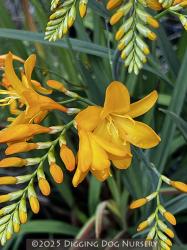
The prized outcome from years of breeding this genus, David Tristram’s ‘Walberton Yellow’ puts on an extraordinary floral presentation. Freesia-like at first glance, two rows of large, closely nestled blooms are upright and open-faced, perfectly poised for viewing. Enhanced by decorative stamens, the sunny yellow petals backed in golden melon hues rise above attractive ribbed green blades, while orchestrating an ebullient symphony with Helenium ‘Bishop’ and Anemone ‘Andrea Atkinson’.
Blooms August–September.
Size: 2' 0" – 2-1/2' high x 2' 0" wide.
Hardy to zone 6.
Each $11.75
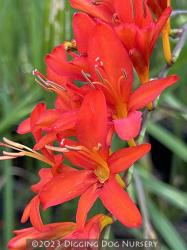
Introduced by British plantsman Terry Jones in the 1990s, this medium-sized Crocosmia sprouts smooth sword-style dark forest greenery beneath fervid-hued flowers. Deep olive and chocolate-tinted stems lift sprays of outward-facing, vibrant reddish scarlet blossoms, each with a sunny yellow eye centering widely-spaced, somewhat recurving petals. Yellow-blooming Rudbeckia fulgida ‘Viette's Little Suzy’ and the dark purple-infused foliage of Aster ‘Black Bete’ enhance ‘Zeal Tan’s bright floral display.
Blooms August– October
Size: 18" – 2' 0" high x 18" wide.
Hardy to zone 6.
Cyclamen
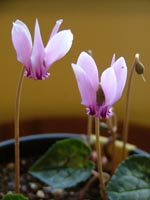
Hardy Cyclamen
These easily grown tuber-forming perennials offer a captivating ground-level attraction from fall through spring. Donning a lustrous finish and often intricately etched with silver, the mounded, dark green foliage is either circular, heart-style or kidney-shaped. Enchanting downward-facing blooms are distinguished by 5 reflexed petals in shades that include white, rose, magenta and lavender. Appreciative of good drainage, slightly acidic soil and dappled light, Cyclamen make elegant bee-friendly additions to understory shrub or deciduous tree plantings, rockeries, shady pathway edges and containers. They can be featured amid ferns, hellebores, Pulmonaria, Daphne, Saracocca and Styrax, where they may experience a summer dormancy and need minimal summer water.
Each $10.75
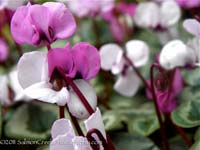
A joy in their own right, copious rounded shiny dark green leaves embellished with intricate silver markings make a lovely fall and wintertime display. Lolling on slender stems, a colorful flood of enchanting blooms ranging from soft pinks to rich carmine shades add further enticements. This long-lived AGM-winning perennial is undaunted by dry shade, appreciates an annual mulch and spreads slowly to form a substantial clump.
Blooms February–March
Size: 4" – 6" high x 8" – 12" wide.
Hardy to zone 5.
Cyclamen coum ssp. caucasicum (P-2317)
Each $12.00
Cyclamen hederifolium ‘Rose Pearls’ (P-1207)
Each $11.75
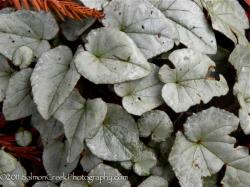
With dainty pink blooms poised above, a silver effulgence splashes across the surface of each polished, prominently veined leaf in a unique fashion, sometimes concealing any sign of greenery, while rich wine hues warm the undersides. Place ‘Silver Leaf Pink’ beneath Elaeagnus ‘Quicksilver’ to enhance the elegant frosty display.
Blooms January–February
Size: 6" – 8" high x 2' 0" – 3' 0" wide.
Hardy to zone 5.
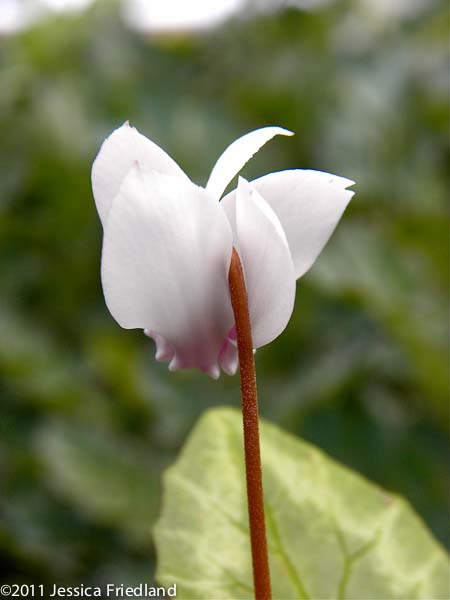
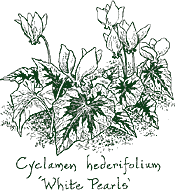
The pristine white nodding flowers gracing this hederifolium cultivar show like comets against the deep green and very decoratively patterned foliage. ‘White Pearls’ serves as a clean and classy understory for Carpenteria ‘Elizabeth’
Blooms October–November.
Size: 6" – 8" high x 2' 0" – 3' 0" wide.
Hardy to zone 5.
Cyclamen persicum var. persicum (P-2313)
Each $12.00
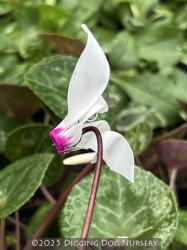
Indigenous to the woodlands, shrubby environs and rocky slopes of Crete, North Africa and extending from southern Turkey to Israel, this tender, long-lived tuberous perennial has been cultivated since 1731. Broad, heart-style silver-patterned foliage fashions a vigorous, dapper dark green mound that sends forth delicate-looking sweet-scented flowers with elegant white or rose-colored petals and magenta mounths aloft leafless, lanky stems from fall until mid-spring. Touted as one of the largest in the genus, it cherishes rich well-drained soil, bright dappled light and lies dormant in the summer.
Blooms October–April
Size: 12" high x 9" – 12" wide.
Hardy to zone 9.
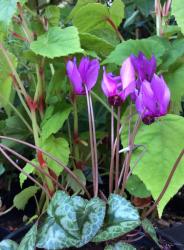
Prized for its fragrant dark purplish pink flowers, this variable widely dispersed European denizen hosts a gleaming bed of round silver patterned leaves with violet-imbued undersides. Cyclamen purpurascens adores moderately moist well-drained sites plus deciduous leaf litter, especially from Beech trees, and imparts endearing summer color to a woodland setting.
Blooms June–September
Size: 2" – 4" high x 12" wide.
Hardy to zone 5.
Cynoglossum
Hound’s Tongue
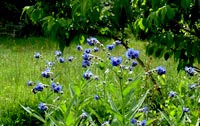
No, its not the blue, oh-so-vividly blue flowers, but the narrow, oblong basal foliage that inspired this Himalayan native’s common name. While the older, rough-to-the-touch bottom leaves show distinctively raised veins, the upper, thinner ones alternate as they cloak the branched stems.
Profuse gentian blue blossoms, resembling those of its cousin forget-me-not, crowd uniquely coiled open sprays, which elongate as the older blooms fade. With an upright bushy habit, Cynoglossum nervosum has specific soil needs: not too dry or overly rich, but always well drained.
Blooms May–July.
Size: 18" – 2' 0" high x 2' 0" wide.
Hardy to zone 5.










